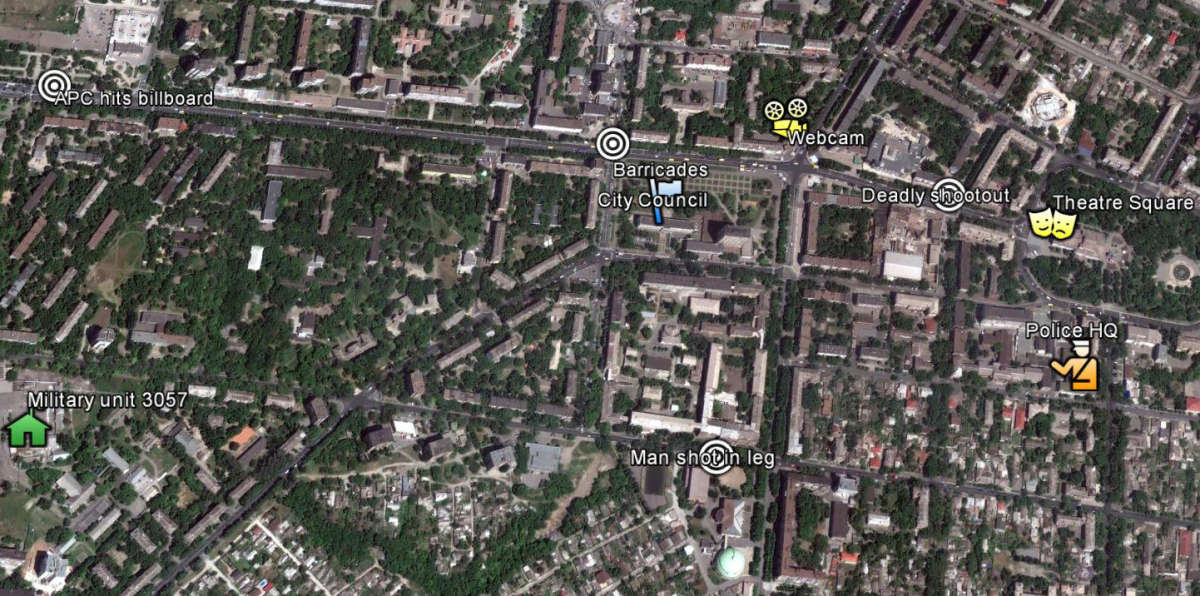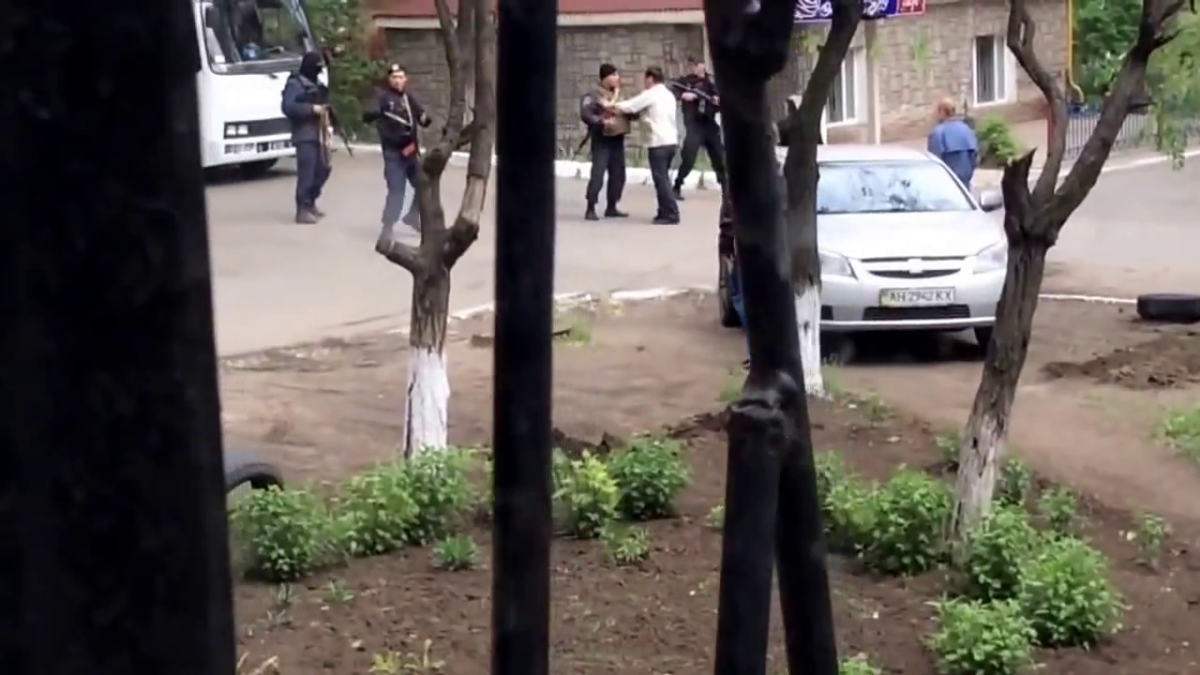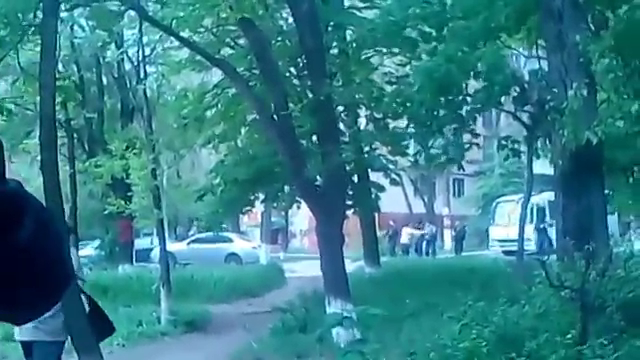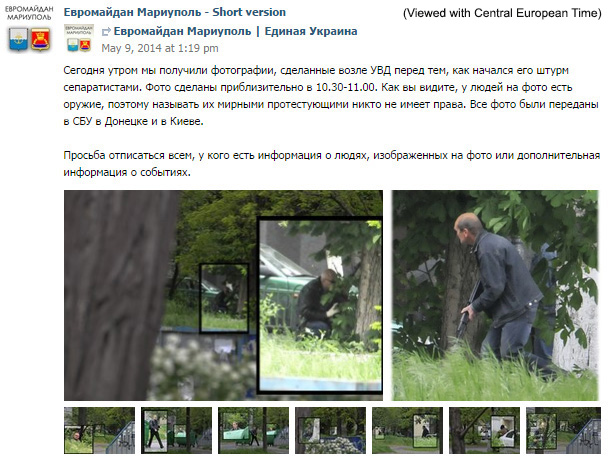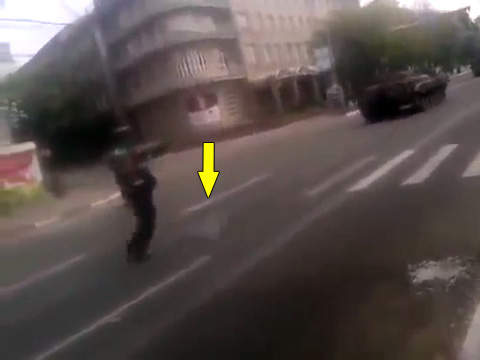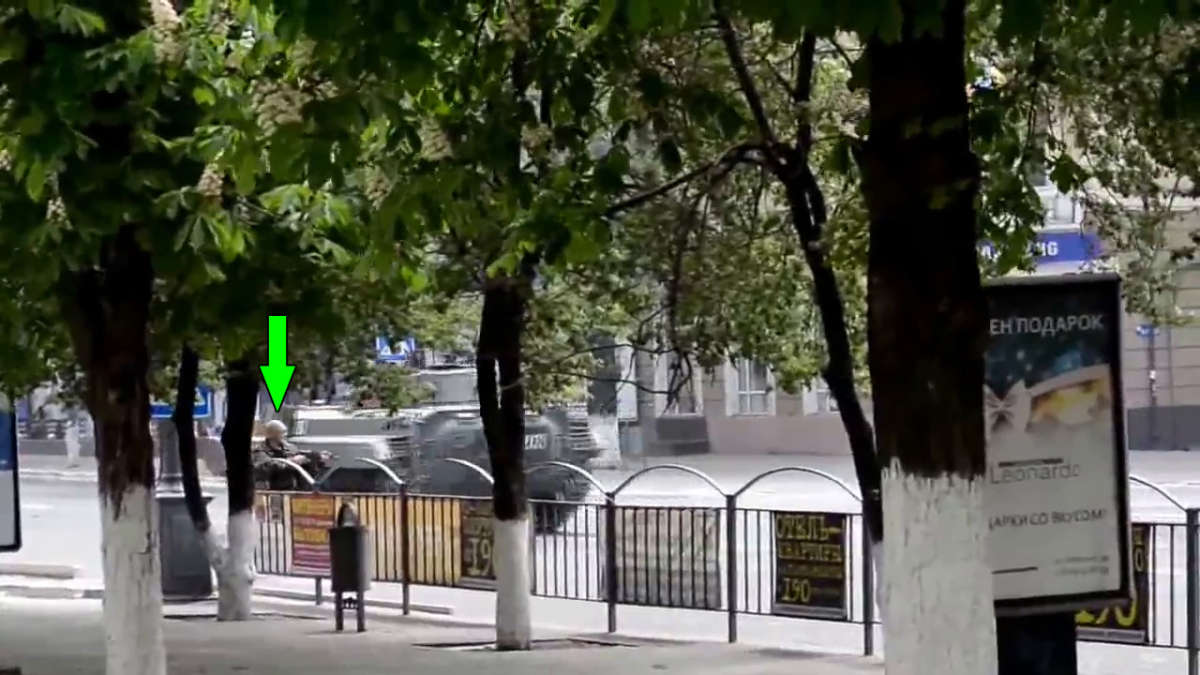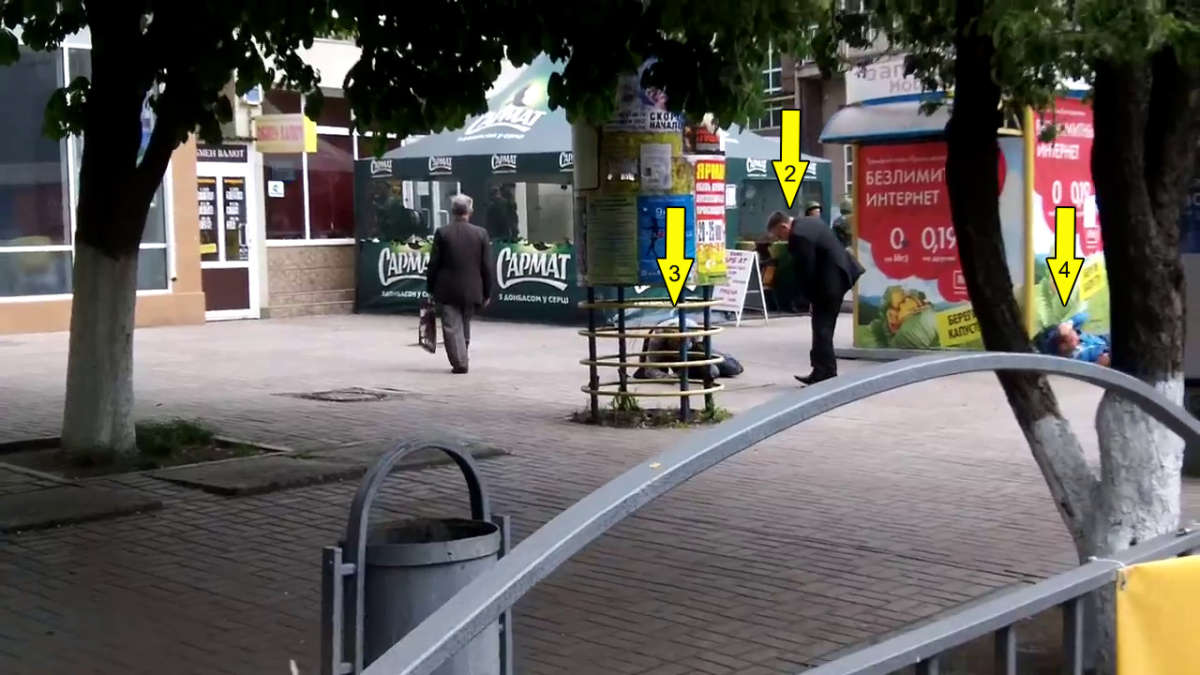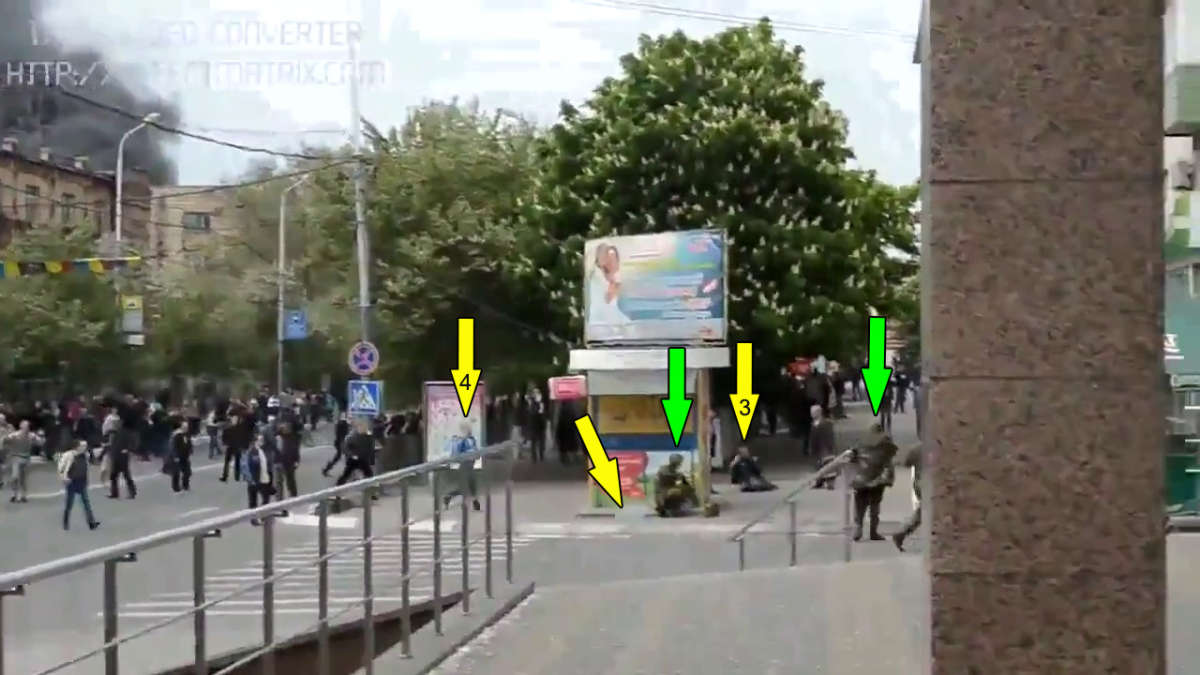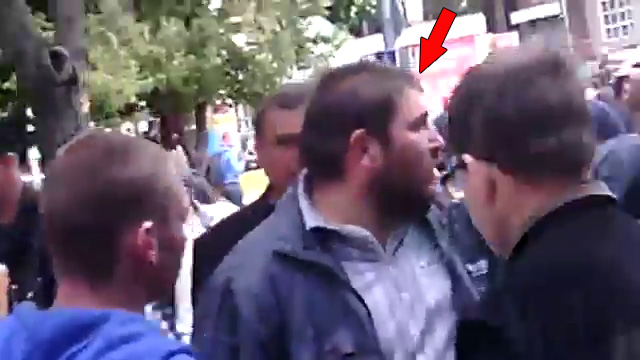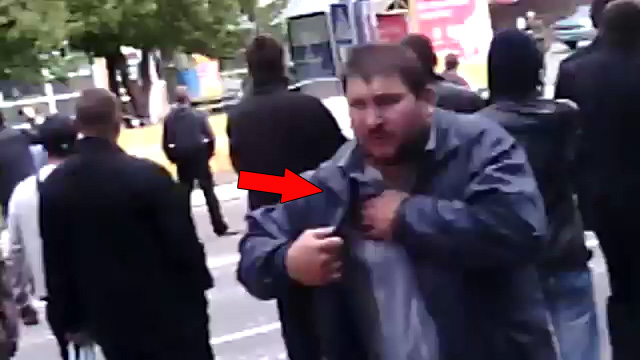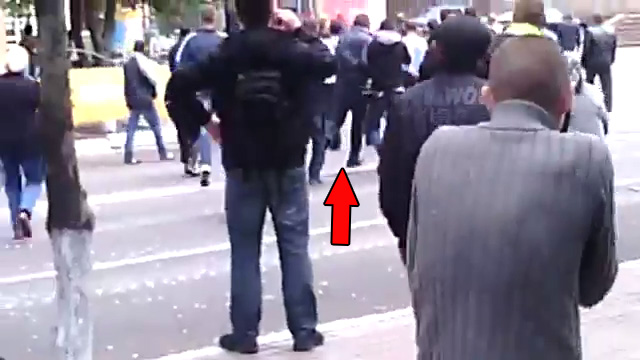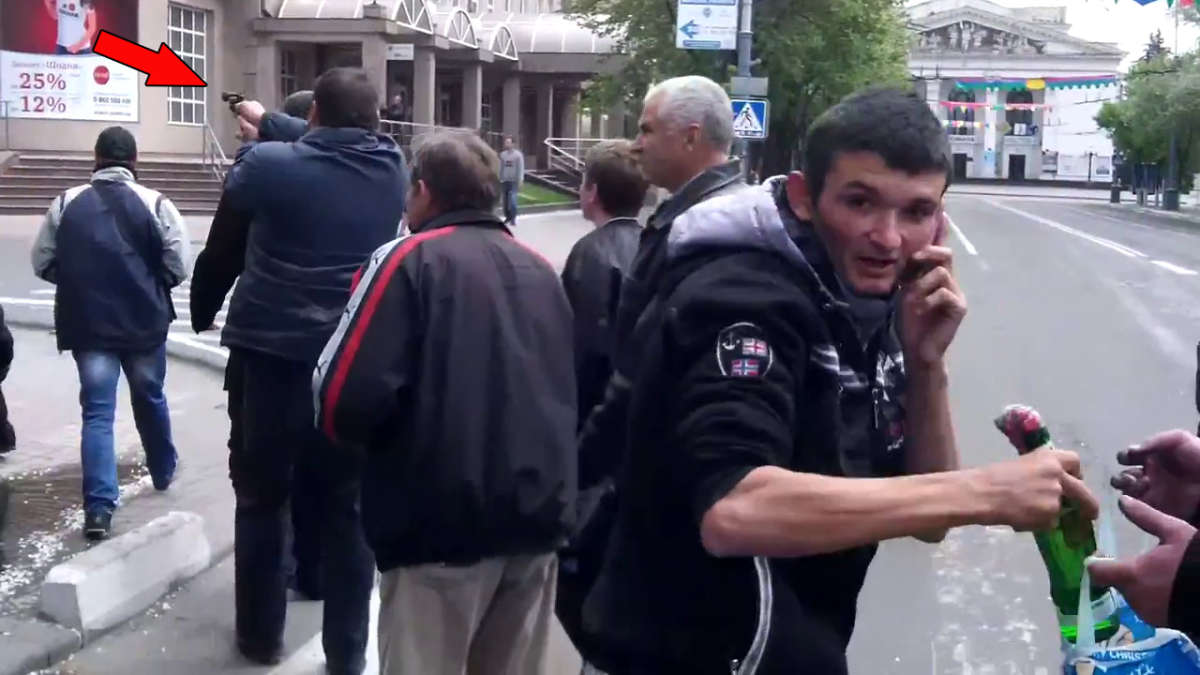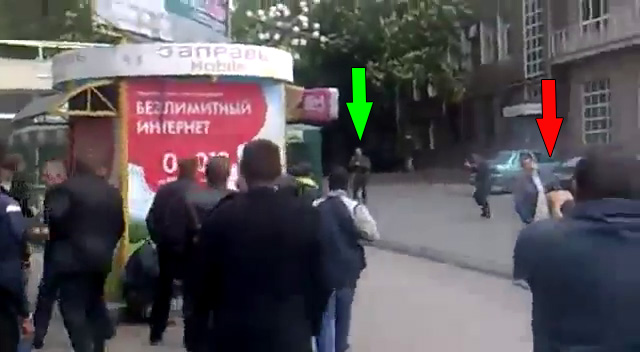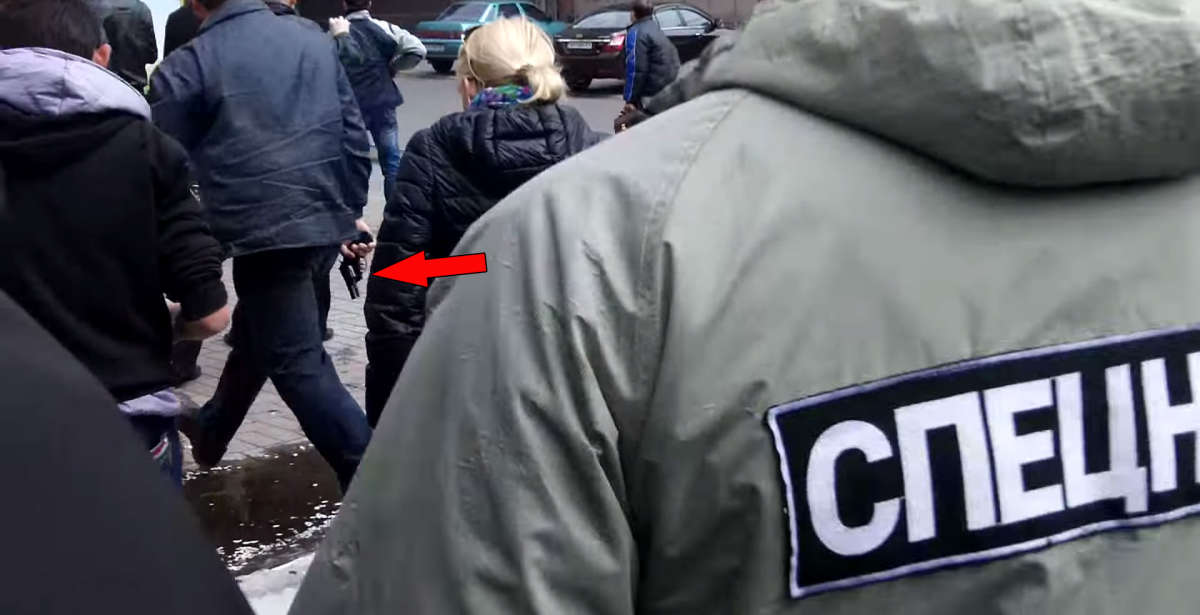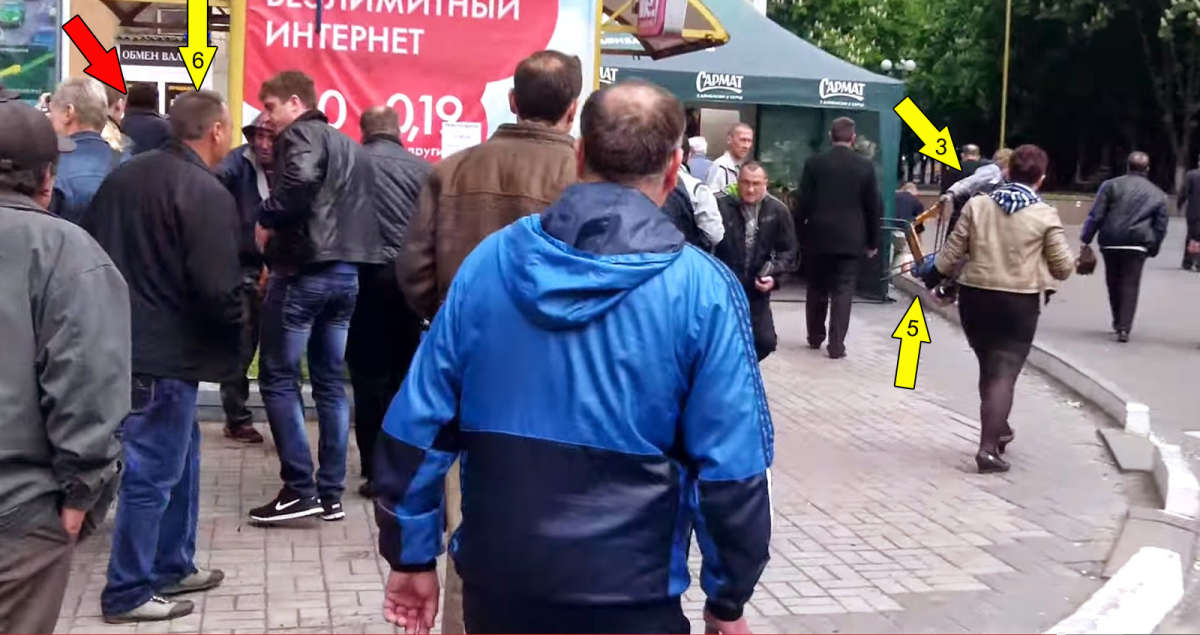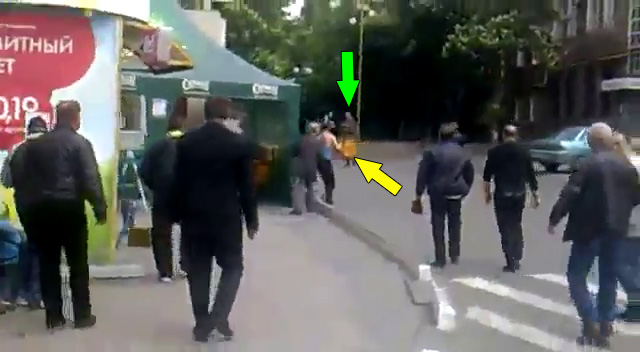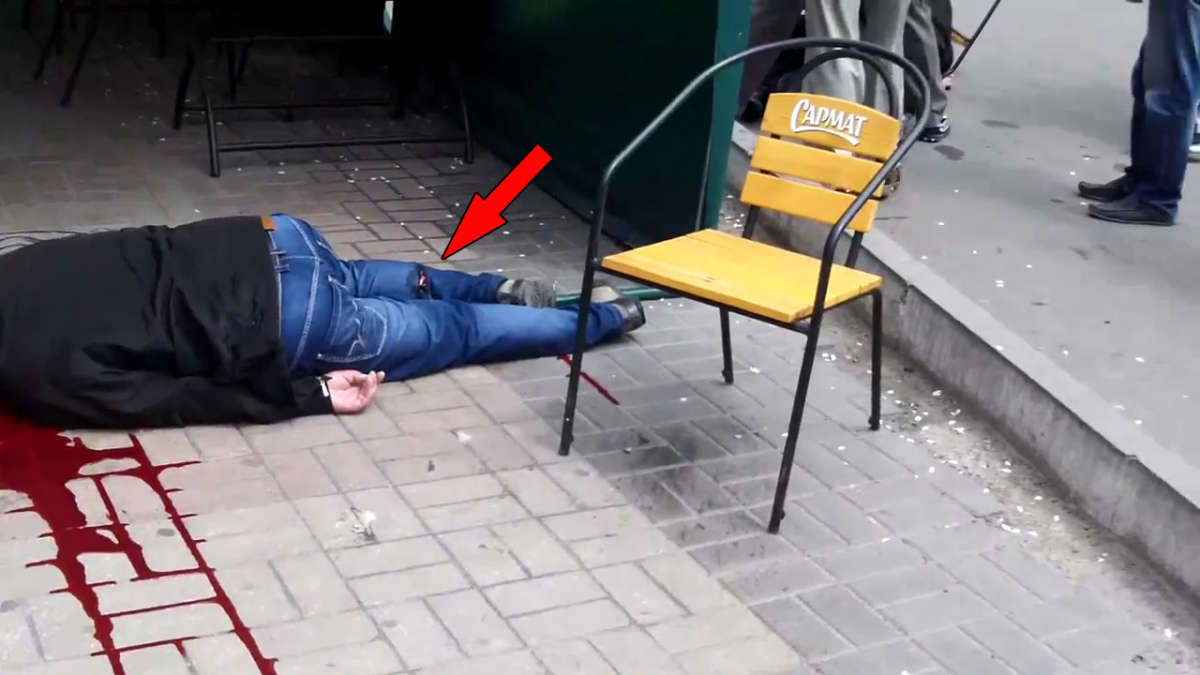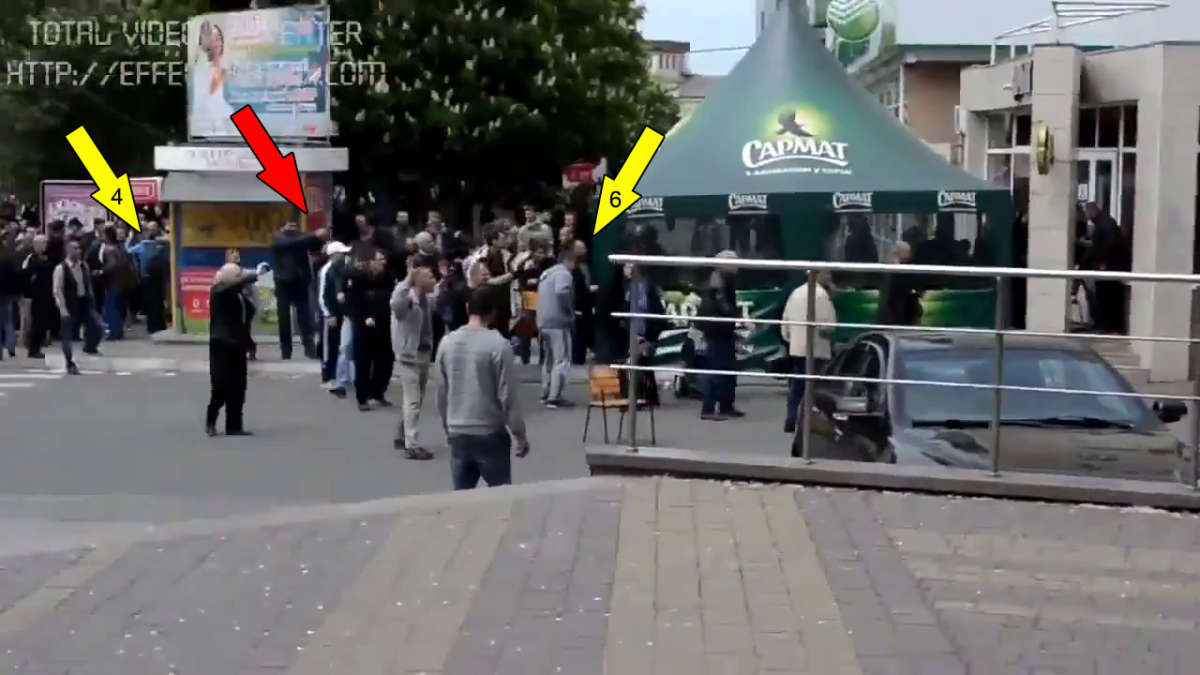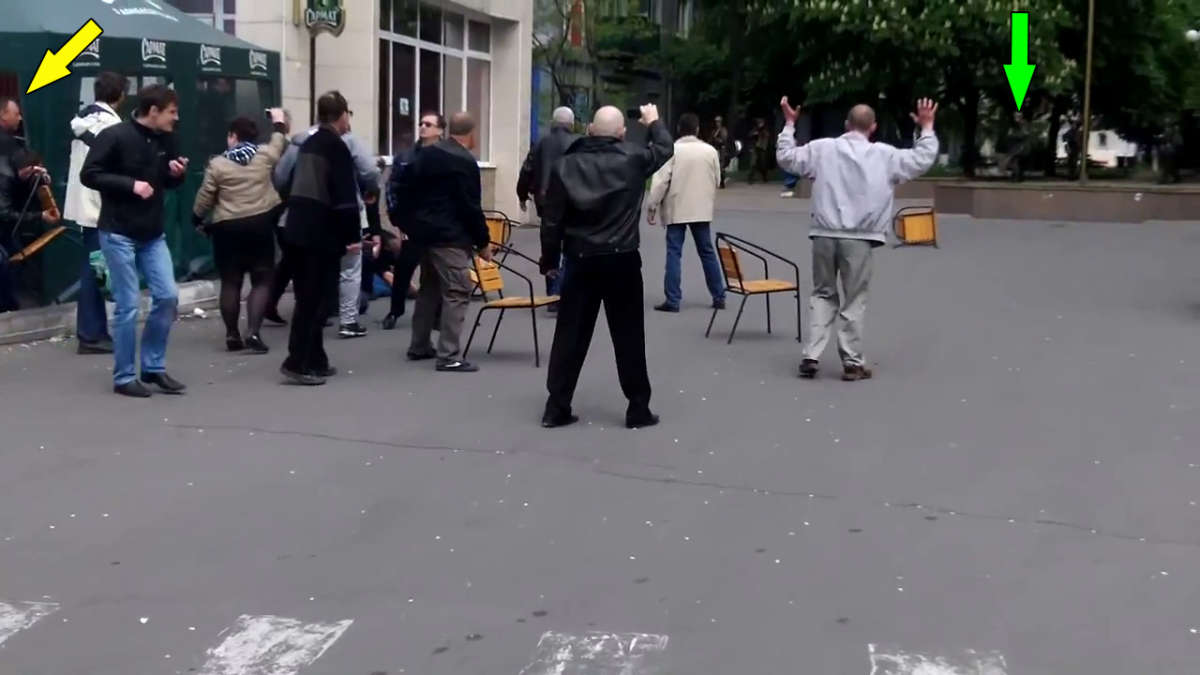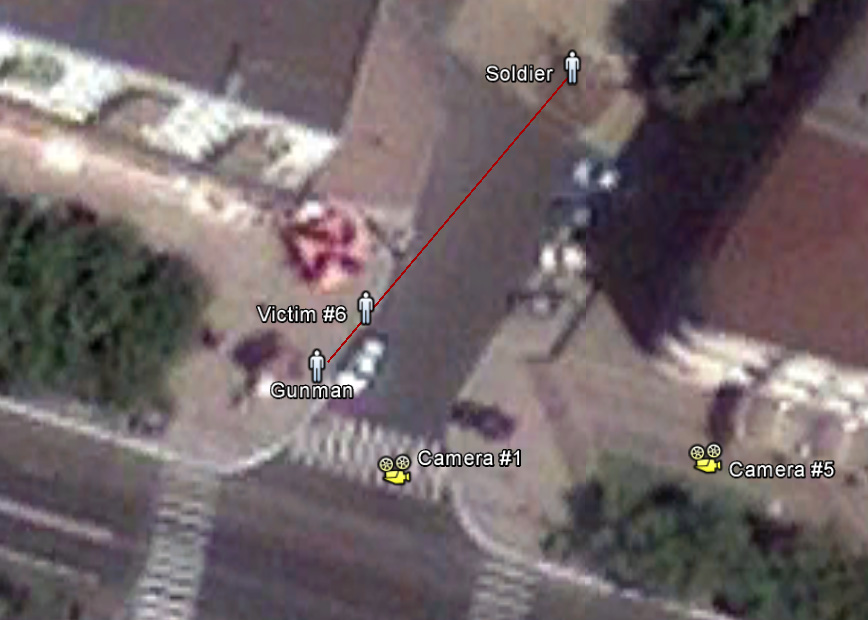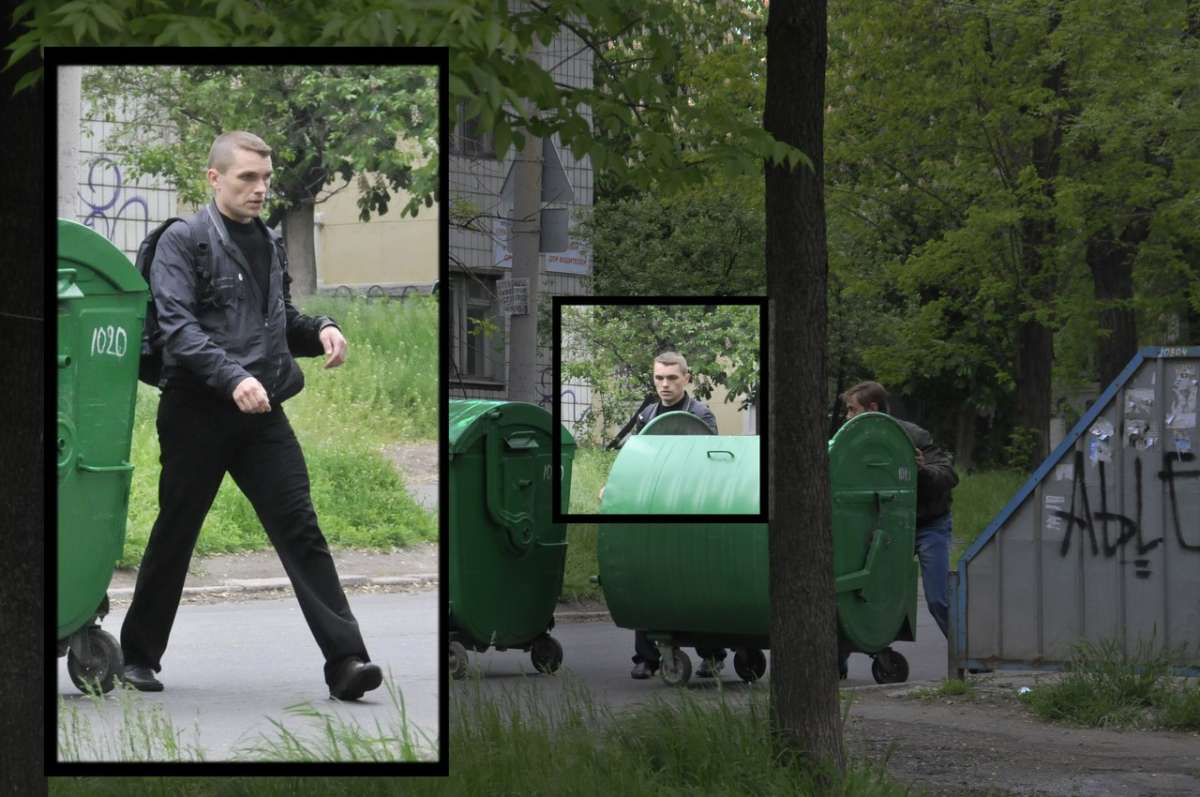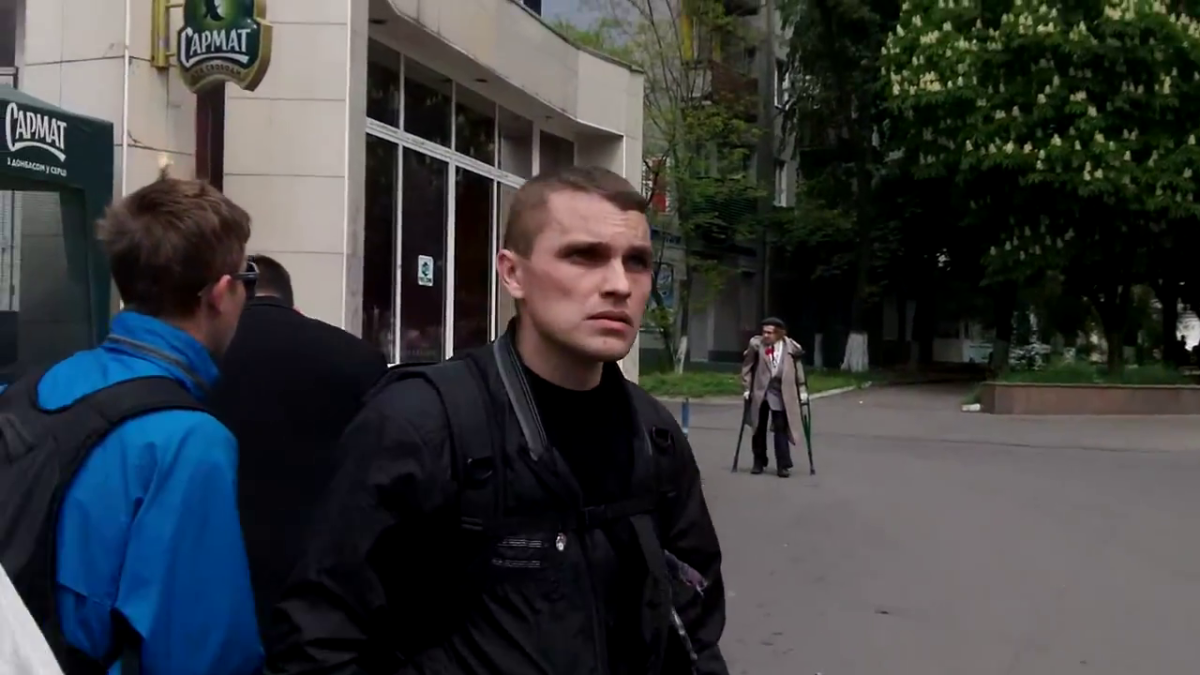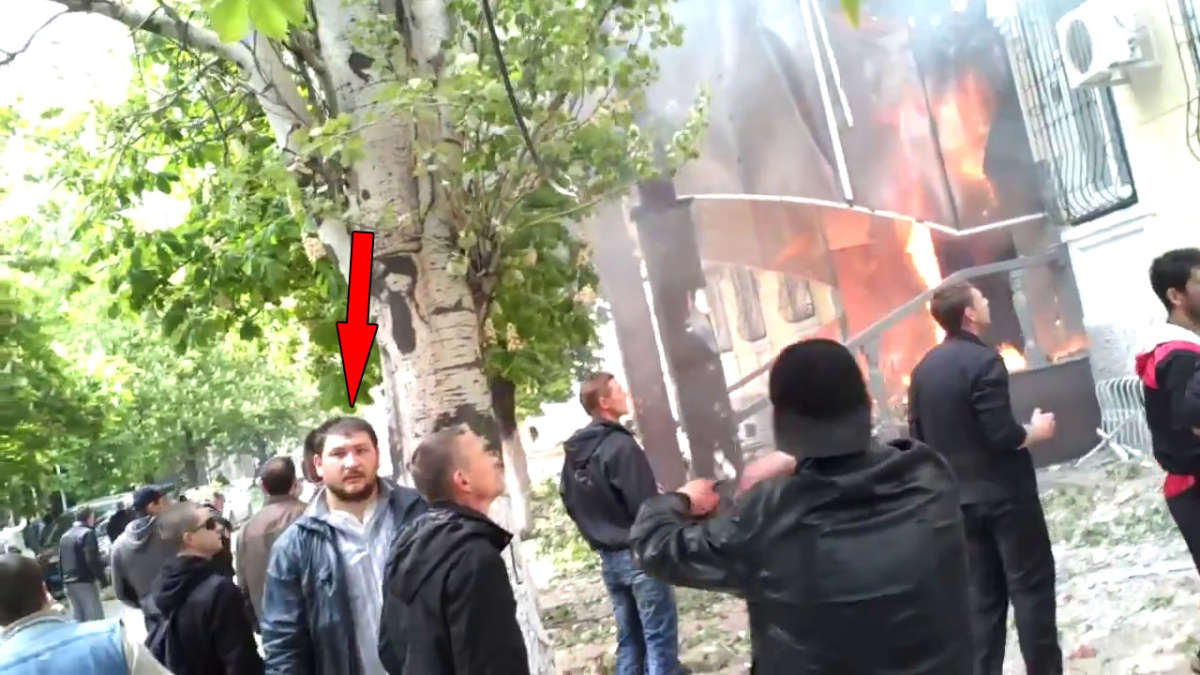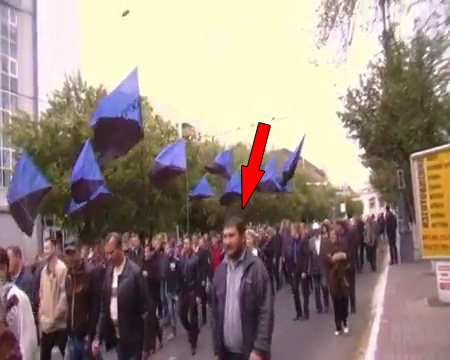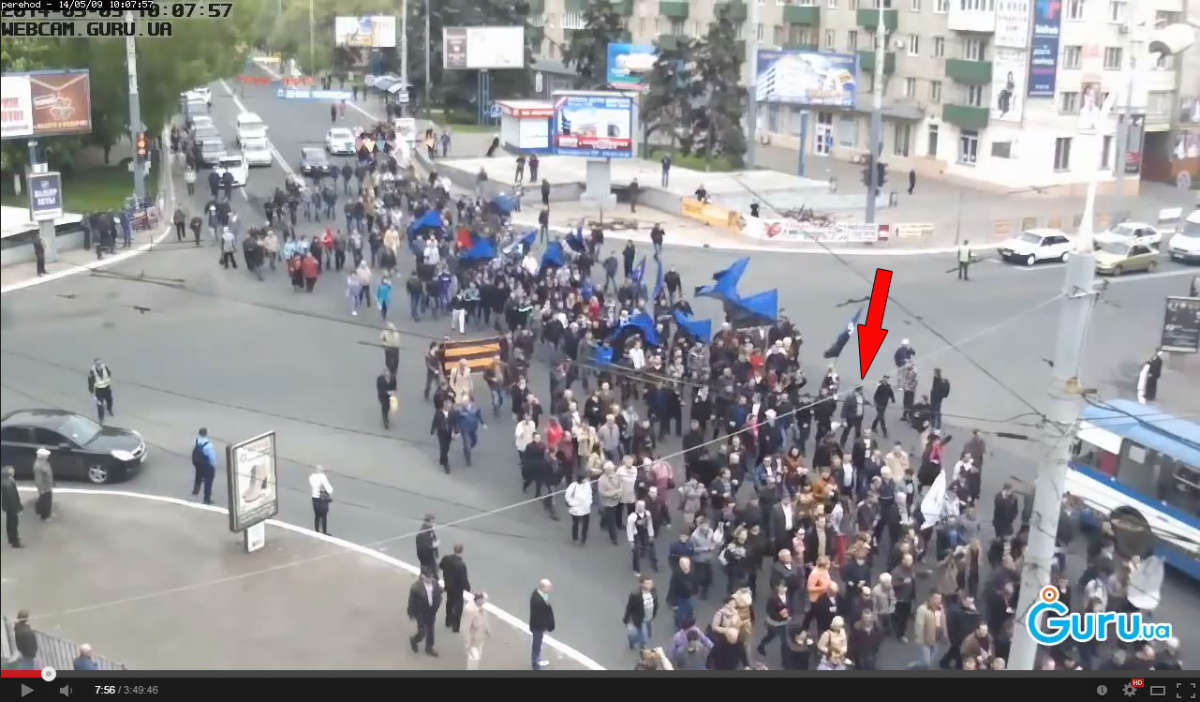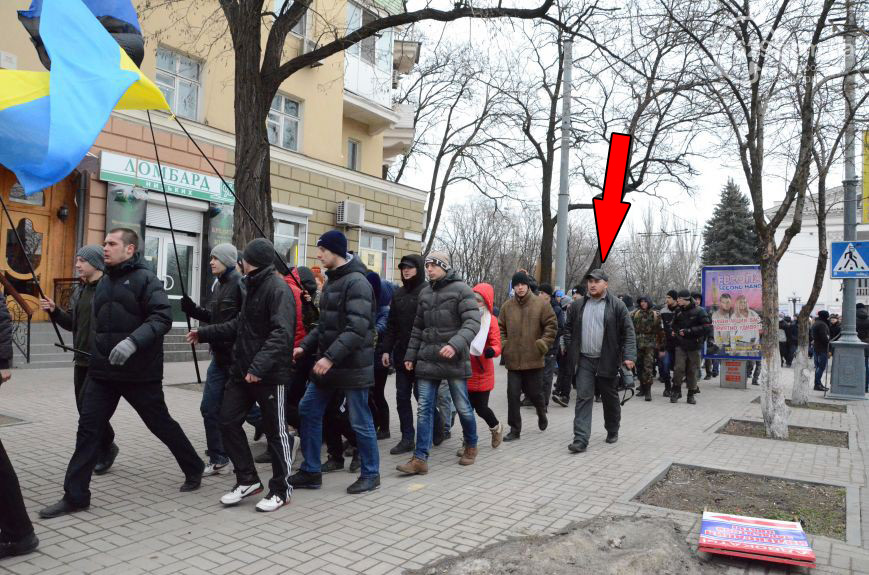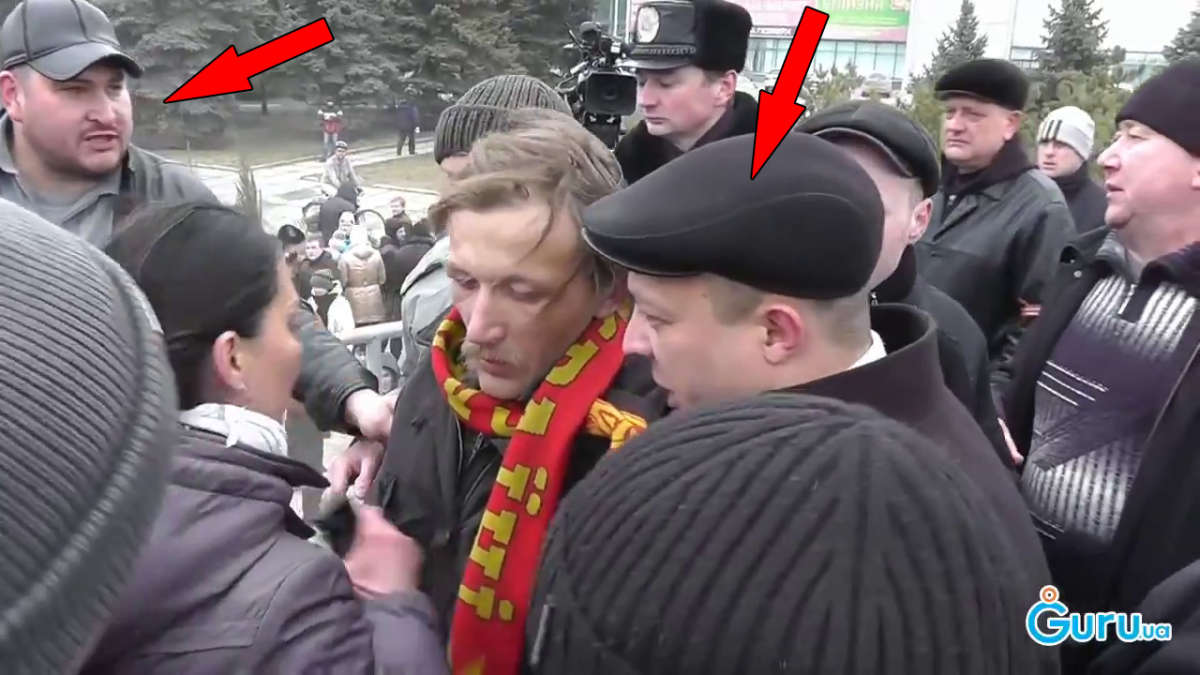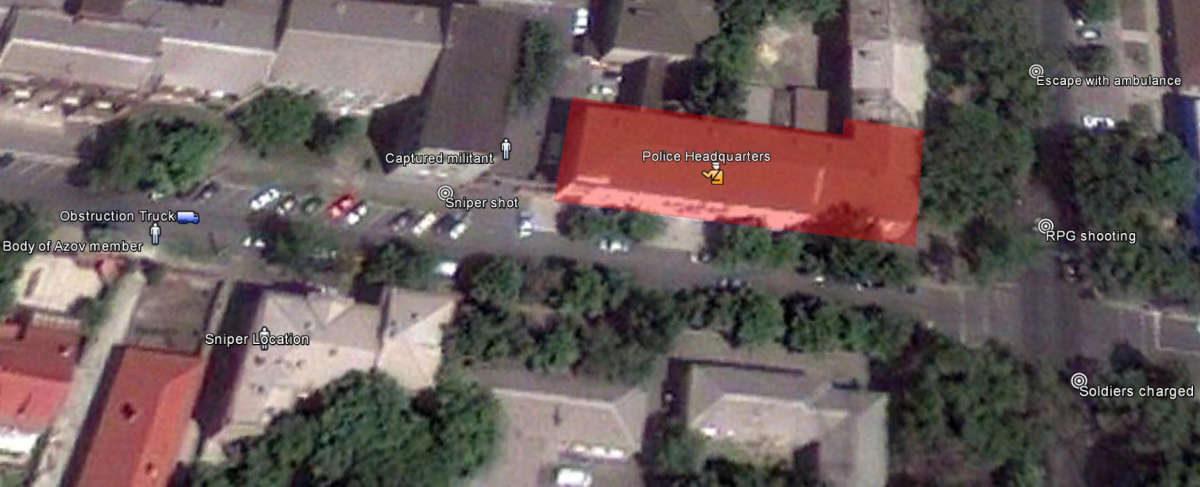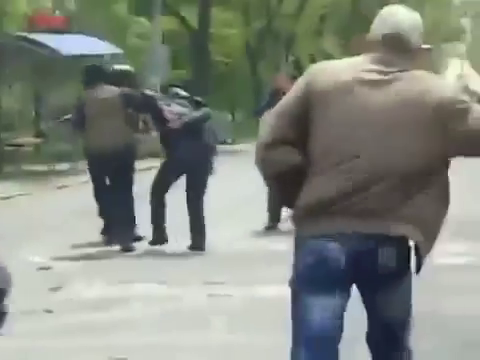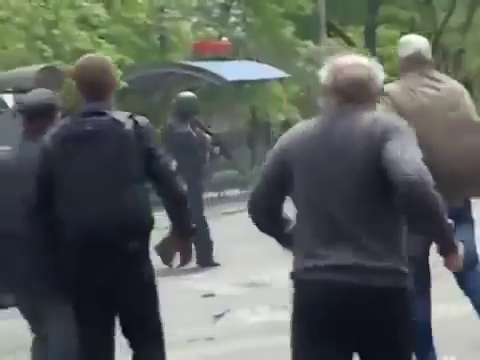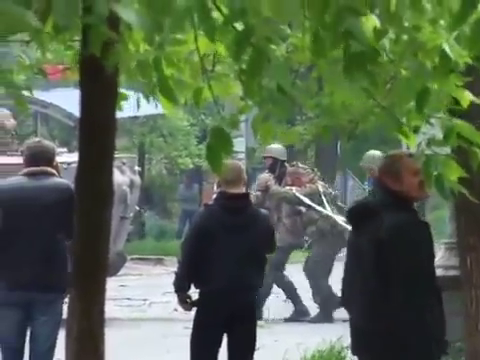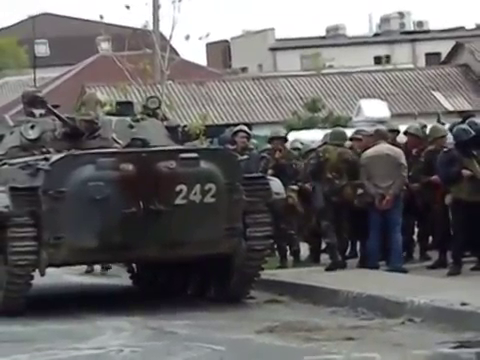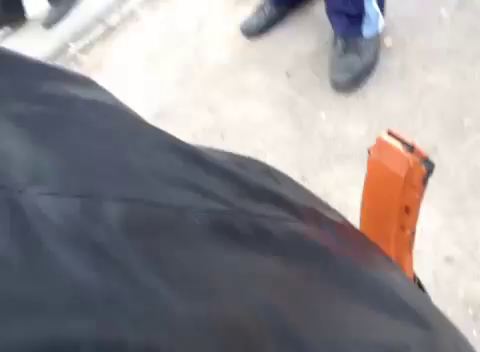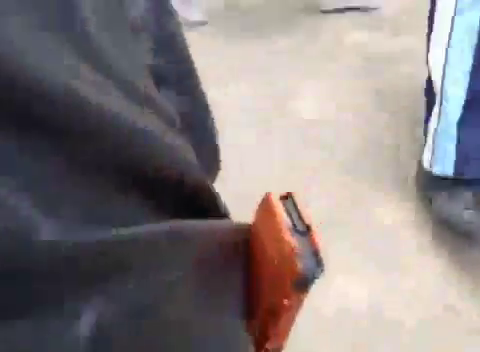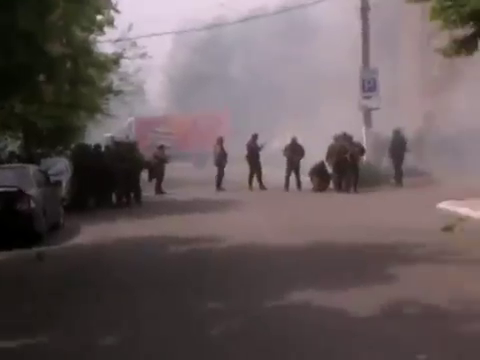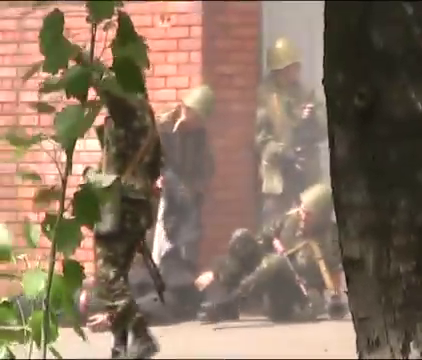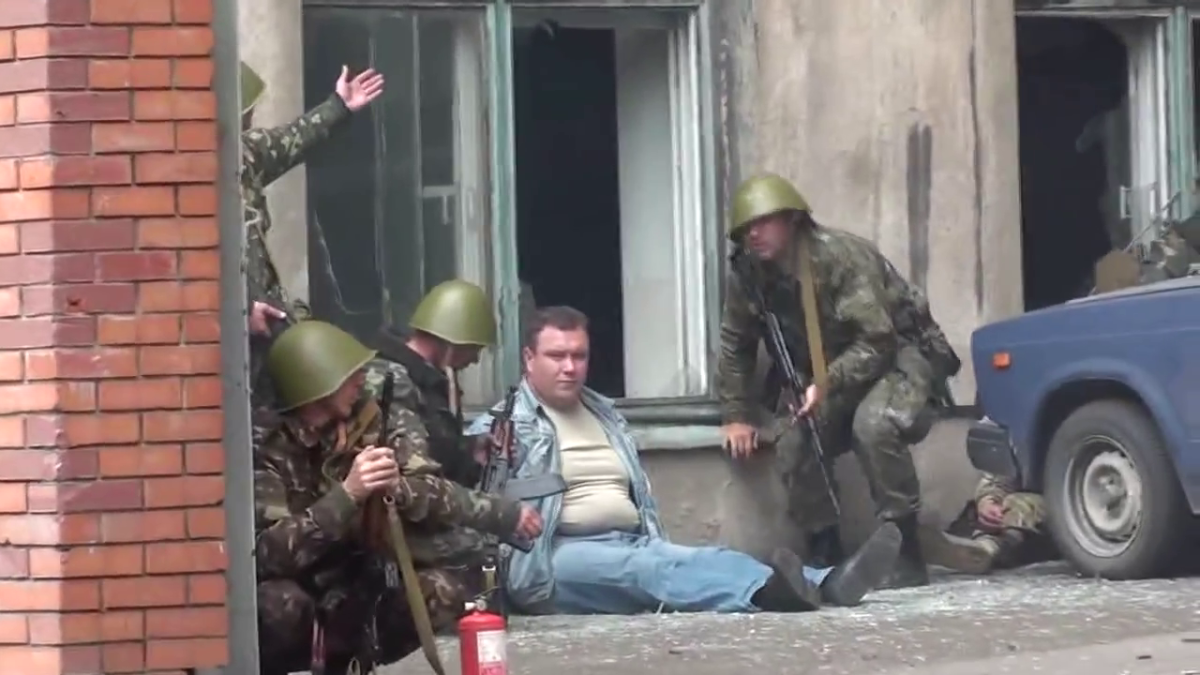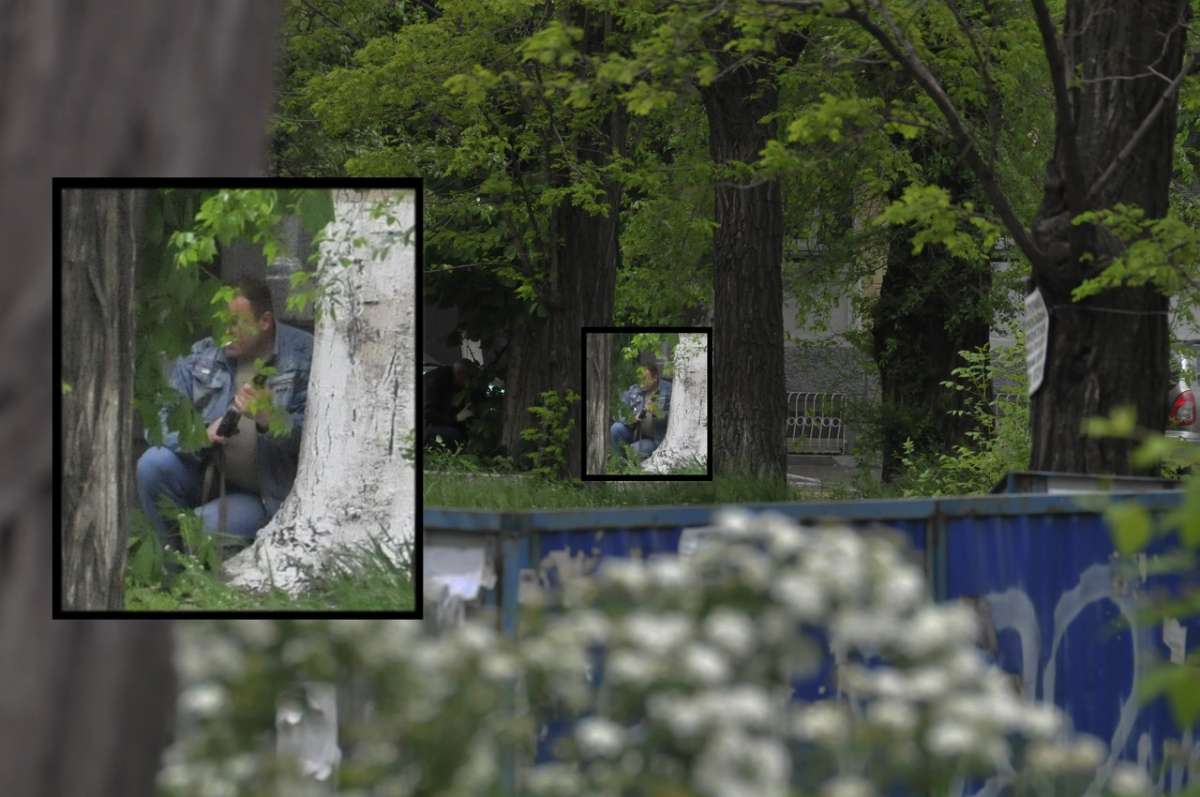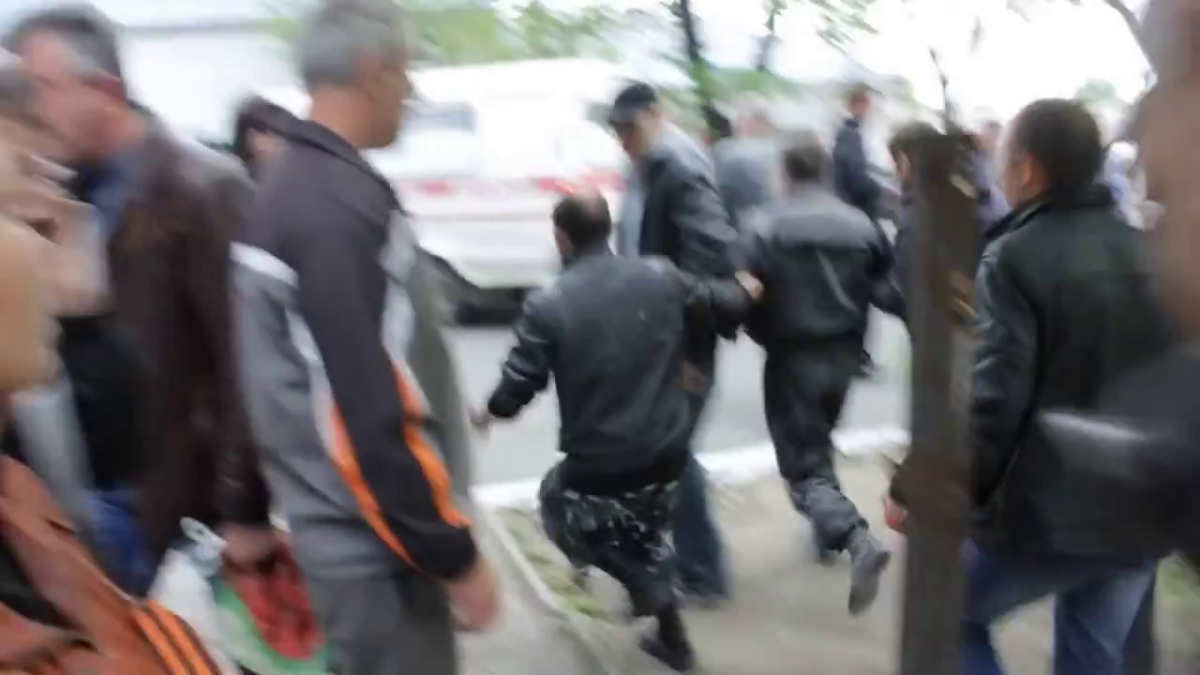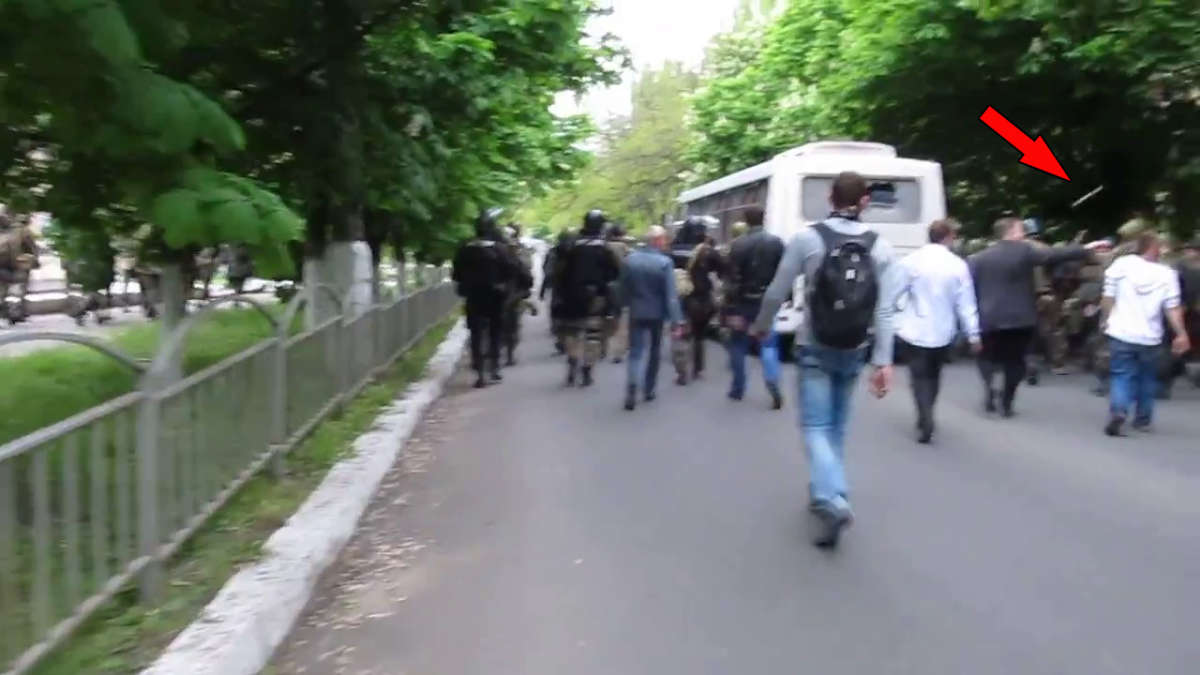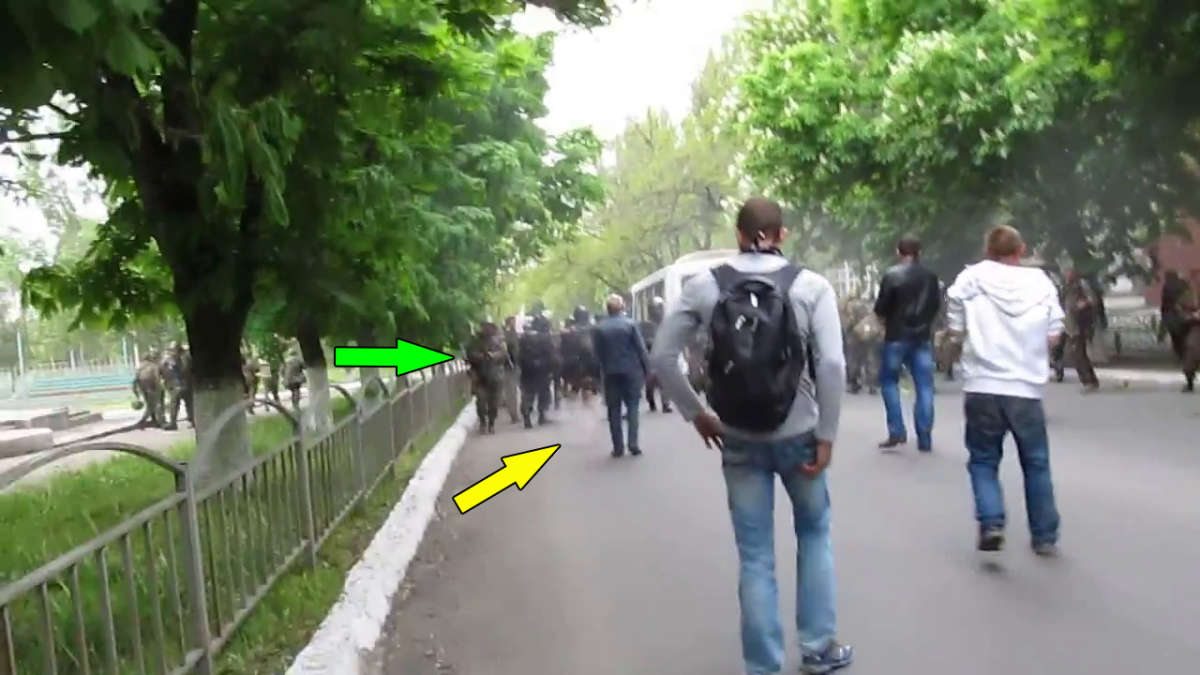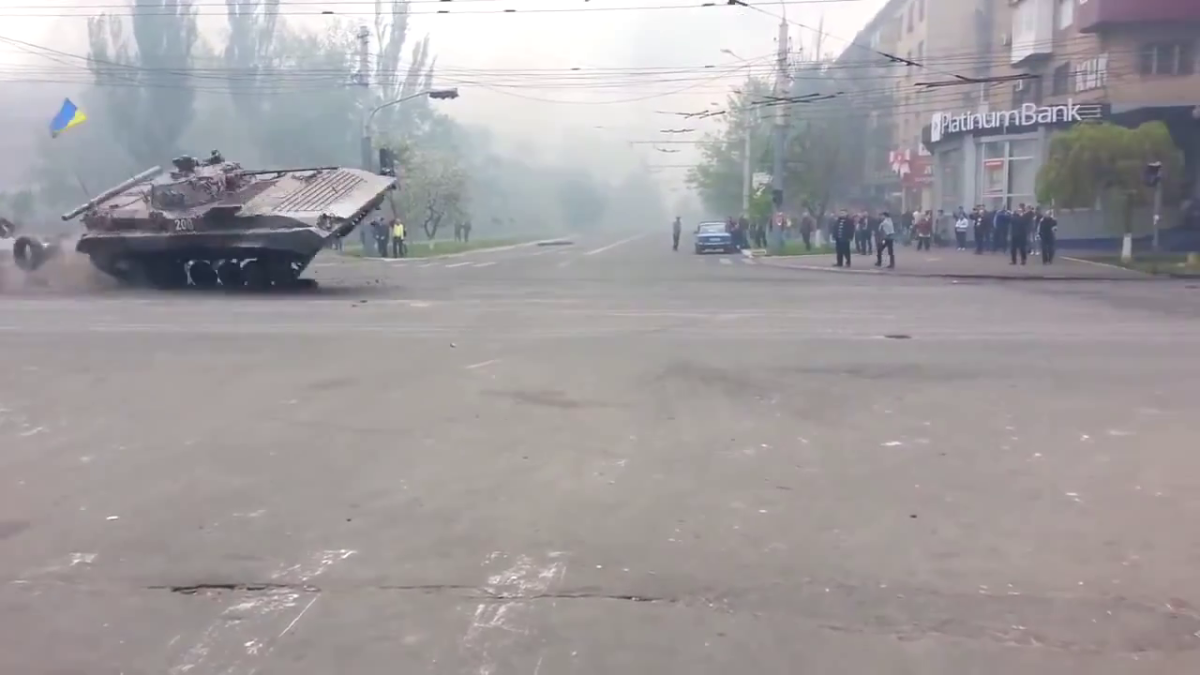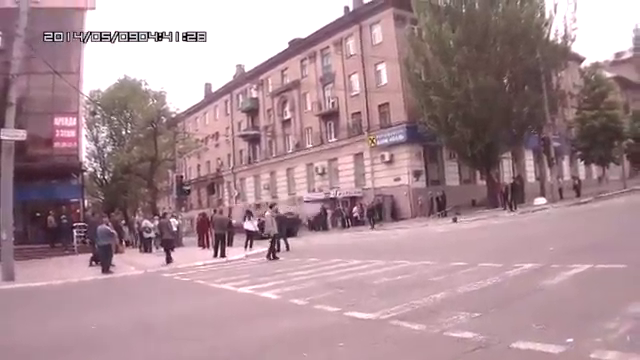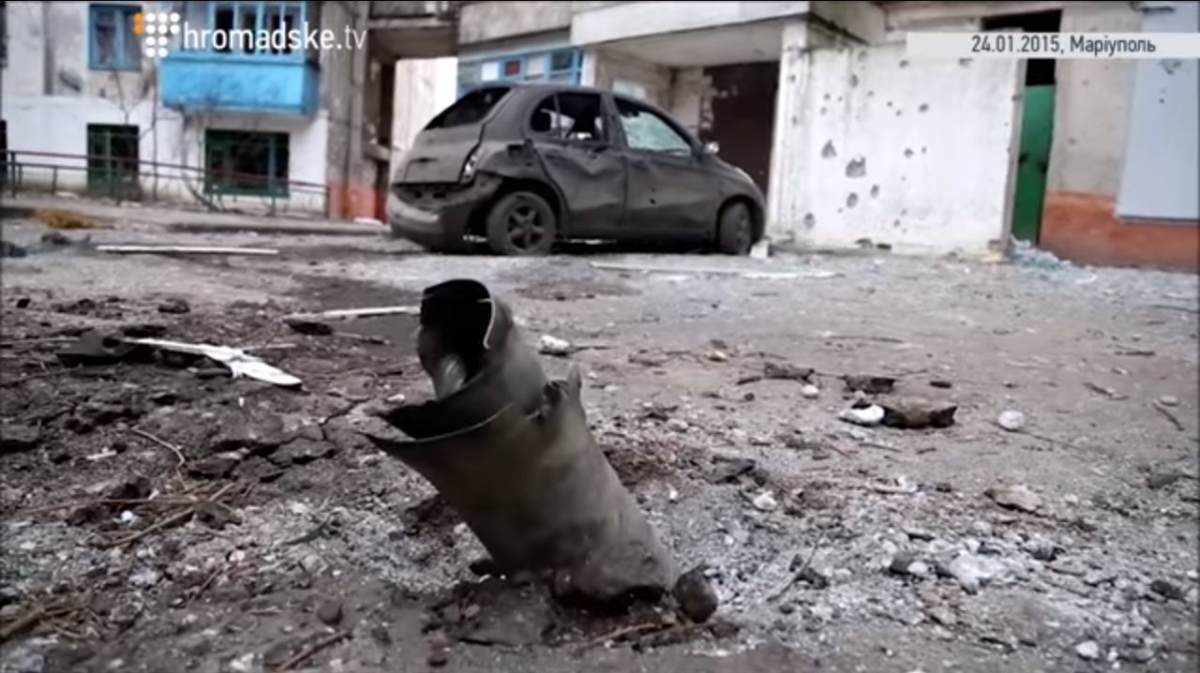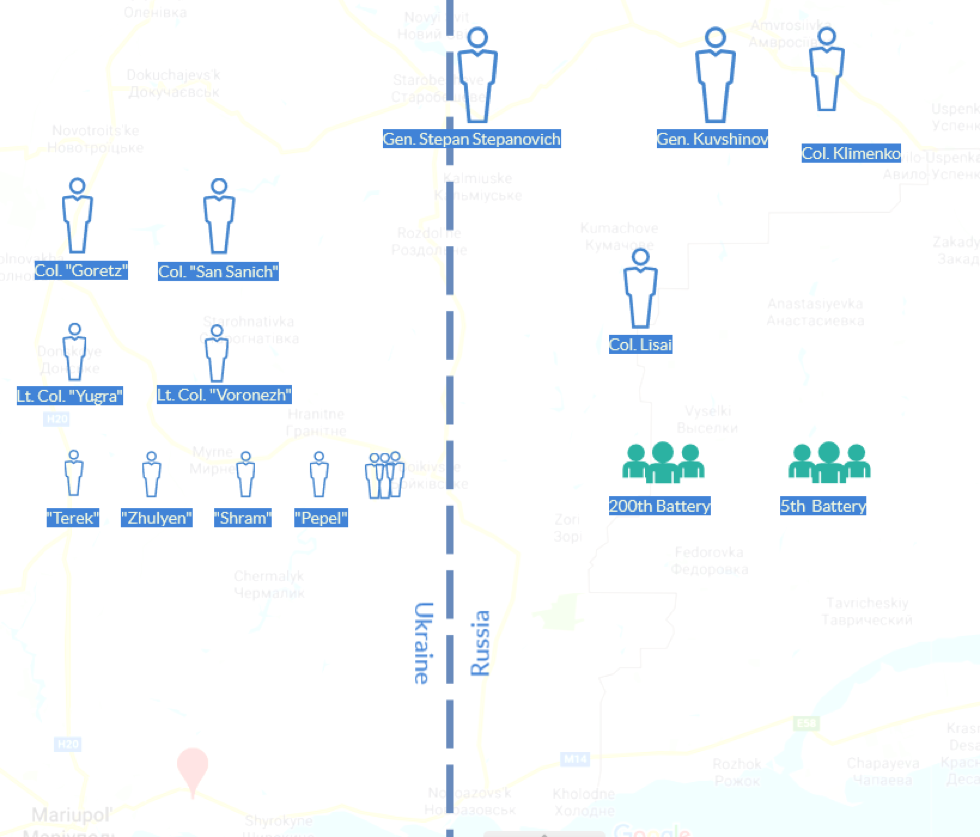A Reconstruction of Clashes in Mariupol, Ukraine, 9 May 2014
On 9 May 2014, the center of the Ukrainian city Mariupol was the site of violent clashes between anti-government activists and the Ukrainian army. More than 200 recordings of the events were uploaded onto YouTube by anonymous protestors, often in an attempt to prove that soldiers used excessive force. In this article, I’ll use these videos to reconstruct the course of events that day. In doing so, I will show why it’s important to scrutinize video content with a critical eye.
This report is split into four sections. The first section examines the outbreak of the clashes, the arrival of Ukrainian forces, and shootings near theater square. The second section discusses some of the clashes’ key figures. The third section examines renewed clashes at the city’s police headquarters and the subsequent retreat of Ukrainian forces. The final section lists and discusses the known casualties.
Background
The city of Mariupol had already seen outbreaks of violence before the events in Mariupol on 9 May. Pro-Russian activists of the Donetsk People’s Republic (DPR) had occupied the city council building since 18 March. In the evening of 13 April a large crowd, many of them dressed in camouflage and wearing masks, stormed military unit 3057 using Molotov cocktails. The military responded with warning shots and then by shooting at the legs of the attackers. The confrontation ended with three activists killed and 16 injured. In one of their reports, the Memorial Human Rights Center held the attackers responsible for the deaths and injuries during the confrontation. Nonetheless, pro-Russian activists used the incident to spread rumors of a “massacre” by Ukrainian forces. On 7 May, two days before the Mariupol clashes, small confrontations between protestors and Ukrainian forces occurred throughout the city. Ukrainian forces were able to retake the city council building with the help of tear gas, but the next day it was overrun once more by the DPR activists. According to Memorial, no one was seriously injured, but rumors again began to spread alleging that Ukrainian forces had shot civilians.
In the former Soviet republics, 9 May is known as Victory Day – a holiday commemorating the capitulation of Nazi Germany. This day coincided with Vladimir Putin’s first-time visit to the recently annexed Crimea. Since the Donbass region had a significant amount of pro-Russian sentiment, it was expected that the Donbass region would have pro-Russian rallies. Indeed, just two days later, a separatist referendum on the status of Donbass was planned.
Section One: The separatist attack (10:00–11:00 AM)
At 10:00 AM local time hundreds of residents began marching through the center of Mariupol in honor of Victory Day. Pro-Russian slogans and calls for the referendum made it clear that it was more than just a Victory Day celebration. Several policemen could be seen marching along, showing Kiev was beginning to lose its grip.
Initially there were no signs of unrest, but soon a video was uploaded showing a small confrontation in front of military unit 3057. The video captures a small group of men unsuccessfully attempting to block National Guard forces from leaving their base:
Another video of the same event shows warning shots being fired. One person was wounded during the confrontation but was able to walk away with the help of others:
The confrontation may have been related to the outbreak of clashes at the police headquarters. Here, a meeting of the heads of law enforcement agencies was interrupted when the building was attacked by a group of armed men. Official estimates of their strength range from 15 to 60. According to Memorial, these militants attacked shortly after 10:00 AM without wearing visible insignia. Intensive shooting was heard from inside the building, and the armed men managed to occupy the first two floors of the building. The meeting members barricaded themselves on the third floor and called for reinforcement. In response, units of the National Guard headed toward the scene. The first troops to arrive were members of the infamous Azov Battalion. The battalion’s deputy commander stated that his unit consisted of 10 fighters. They were dressed in plainclothes. Considering that Azov fighters normally wear uniforms, they were most likely unprepared for the separatist attack. The Azov fighters entered the police headquarters and managed to secure the first floor of the building.
While the armed separatists held the second floor and besieged meeting members continued to maintain their barricade on the third floor, additional forces from Ukraine’s National Guard began to arrive. Due to a lack of coordination, the National Guard didn’t know how to distinguish between friends and foes; they arrested three members of Azov and Mariupol’s head of the Security Service of Ukraine (SBU).
The separatist attacked went unnoticed by most residents, as the police headquarters was not close to the Victory Day march. The fighting did, however, cause rumors to spread that Ukrainian forces were attacking policemen because they had chosen to side with the DPR. This was later also alleged by the leader of the Ukrainian Communist Party, Petro Symonenko, who stated that the policemen refused to carry out orders to disperse a pro-Russian rally. This version of events still remains popular on the Internet and in pro-Russian circles. Evidence to the contrary appeared in the form of anonymously taken photographs depicting the separatist militants in action, which were posted on a pro-Kiev social networking website:
These photographs show eight plainclothes men in front of the police headquarters, some of them armed with automatic rifles. Since no damage to the buildings can be seen, it’s clear that these were taken in the morning before the fighting. Some of the attackers were later identified on social networking sites as citizens from Mariupol.
Entry of the Ukrainian military (11:15 AM)
At approximately 11:15 AM, the first armored personnel carriers (APC) from Ukraine’s 72nd Guards Mechanized Brigade drove into Mariupol. They drove on Lenin Prospekt (Lenin Avenue) in the direction of Mariupol’s theater. The time of their arrival is based on webcam footage filmed at the intersection of Lenin Prospekt and Metalurhiv Prospekt, which showed the first two APCs (numbered 240 and 241) passing at about 11:25 AM. Their arrival was delayed because, just prior, one of the APCs had crashed into a billboard. Some commentators suggested that the APC deliberately knocked over the billboard because it may have advertised the Donbass referendum. It seems more likely that the APC had mechanical issues, since later that day the same APC (240) was abandoned due to engine failure. Residents by this time had begun recording clashes between soldiers and protestors. To reconstruct what happened, I will use the following video as a reference point:
Video 1 (1st part) – Duration: 39m19s (2nd part is here).
Based on the webcam footage, this video starts just before 11:25 AM, which allows us to understand how the standoff began. The beginning of the video shows APCs driving eastward on Lenin Prospekt. An angry crowd of about a hundred people gathers at the crossing with Ulitsa Kazantseva (Kazantseva Street). This crossing is near the city council building – the headquarters of Mariupol’s separatist movement. Some of the protestors throw rocks and tires and manage to block one of the APCs by forming a human chain. One of the activists climbs on top and tries to cover the vehicle’s sights. Two warning shots are fired from within the APC, and eventually it manages to pass. One protestor receives a wound to the head from a brick thrown at the APC, which can be seen at 3m39s.
As the cameraman runs after the APCs, distant firefights are already audible in the background. Ukrainian soldiers can be seen covering the northwestern and southwestern corners of Ulitsa Engels in order to secure the crossing of troops coming from the south. The crowd follows but initially keeps its distance. They are then persuaded by advancing protestors to close in on the soldiers. Warning shots are heard, but the crowd ignores them and slowly continues forward.
Injuries near theater square (11:56 AM)
Another injury can be observed at 31m45s, when one of the protestors, who I will call “Victim 1,” can be seen kneeled down on the road. Earlier on, Victim 1 persuaded the crowd to block the APC at Ulitsa Kazantseva and to close in on soldiers covering Ulitsa Engels. This video (Video 3), shows him nagging one of the soldiers at 4m04s. When a new column of APCs passes by, Victim 1 crosses the street. Three shots are then heard, and at 4m24s, a bullet impact next to him shows he’s being shot at:
This video (Video 2) shows how one of the soldiers fires two shots at the ground near the victim’s feet (at 6m40s):
Afterward, bystanders help Victim 1 stand up and assist him toward the sidewalk. Memorial judged Victim 1 to be “heavily intoxicated” and suggested that the shot may have saved his life, as otherwise the APC, driving at high speed, would have hit him. Video 3 shows a wound near his armpit (at 5m47s). Since the soldier aimed downwards, it seems that the victim was struck by a ricocheted bullet. This is a recurring feature throughout this reconstruction; sometimes soldiers seem unaware that shooting at a hardened surface can cause a bullet to ricochet.
As the last soldiers cross Lenin Prospekt, soldiers standing at the northwest corner of Ulitsa Engels fire more warning shots. One of the protestors, wearing a suit and holding an ID-card (Victim 2), moves closer towards the soldiers, and at 32m58s a 7 bullet strikes near his feet. He ignores the warning shots and continues forward, closely approaching one of the soldiers. He is joined by another protestor (Victim 3), who is crawling forward on his knees. The end of Video 2 shows the soldiers consistently signaling them to keep their distance. Warning shots are fired, but the two continue forward. At 34m16s three shots can be heard. After the second shot, Victim 3 drops to the ground and grabs for the left side of his face. He crawls away shortly afterward. Victim 2 also tries to walk away from the scene but drops to the ground due to an injury to his leg. Right after the third shot, a photographer in blue (Victim 4) can also be seen dropping to the ground against a small kiosk:
When Victim 2 and 3 drop, the cameraman can be heard saying “ricochet wounded.” Footage from the aftermath reveals that Victim 2 has a small wound to his left upper leg. It appears that he was either hit by a ricocheted bullet or impact debris from the pavement. Shock probably contributed to his collapse. In this video (Video 5), at 0m30s, Victim 4 can be seen sprinting around the kiosk, while seemingly unaware that a soldier is squatting just around the corner. When another soldier fires a shot the impact of the bullet is clearly visible in front of the photographer:
Since no other shots can be heard, it can be concluded that Victim 4 wasn’t hit by direct fire. Furthermore, Victim 3 doesn’t really appear to be seriously injured; at 34m54s he can already be seen trying to throw a chair at the soldiers. After the shootings, one frame at 36m58s shows that he has a small amount of blood above his left eye.
A stabilized version of the shootings confirms that Victim 4 was most likely hit by a ricocheted bullet or by debris from the bullet’s impact. 46 seconds later he can be seen standing up. The video also shows more clearly what happened to Victim 3: just before he drops, an unknown projectile coming from above can be seen hitting his face. Since the victim had a bruise on his left side, the projectile came from his left hand side. It’s unclear what hit him, but it was certainly too slow for a bullet.
Note: Victim 4 wasn’t Russia Today’s Ruptly stringer Fedor Zavaleykov, as some had reported. Zavaleykov was instead wounded later near the police headquarters. There, under unknown circumstances, he was shot in the stomach but was saved by a bulletproof vest. He was also present in the crowd at Lenin Prospekt; he can be seen in Video 1 at 12m45s (and not yet wearing a bulletproof vest).
Deadly shootout at café Arbat (11:59 AM)
When the three victims are seen dropping to the ground, the crowd becomes bolder and the situation quickly escalates. Just before this happens, a gunman makes his first appearance. In this video he can be seen (at 5m12s) talking to the crowd near the crossing with Ulitsa Engels, and can be heard saying: “look, there/who is walking, [we] must by, fuck, by, inaudible“:
At 5m33s, when the three victims are injured, he grabs for his gun:
Given his location at the time, he didn’t witness firsthand the injuries of the three victims. When part of the crowd begins charging towards the soldiers, the gunman runs with them:
At 34m42s of the main video he aims his revolver toward the soldiers and fires two shots (a protestor can also be seen handing out Molotov cocktails in the same frame):
The shots can also be observed in this video (Video 4) at 2m52s:
A protestor can also be seen shooting a slingshot toward the soldiers shortly thereafter.
After firing the two shots the gunman walks around the kiosk. One of the frames reveals his gun more clearly, which looks like a standard .38 revolver:
Together with the sound of clearly audible gunshots, this proves that Memorial’s assertion that he was firing a stun gun is incorrect.
At 34m50s a victim who is about to become mortally wounded (Victim 6) makes his first appearance; he can be seen running towards the tent outside café Arbat:
Another person, (Victim 5) is seen lying on the ground; at 2m59s, Video 4 shows how he is shot in the leg when he runs toward a soldier with a chair:
At 35m05s two rapid shots can be heard that resemble the earlier shots from the .38 revolver. This is followed by five rapid shots fired by the soldiers. This is when Victim 6 is shot in the head, which is confirmed by graphic footage of him lying in a pool of blood. He has a large wound to the head and another on his right lower leg:
In Video 5 the gunman can be seen firing two shots at the soldiers (at 1m15s) and then quickly ducking behind the crowd. One of the soldiers responds by shooting five times at the crowd. The original video is too shaky to establish how Victim 6 is shot. A stabilized version of this video (originally produced by the Ukraine@War blog), however, shows that the third bullet hits him in the leg and, as he is dropping to the ground, the fourth or fifth bullet hits him in the head.
Video 1 can be used to find out which one of the soldiers fired the shots. Again a stabilized version shows more clearly that one of the soldier fires the shots as he’s walking backwards:
The footage allows us to establish all positions during the shootout:
Judging by the footage and these positions, the soldier who fired the five shots was most likely also the one shot upon by the gunman. After firing his revolver, the gunman hid behind another member of the crowd, using him as a human shield. The soldier noticed someone trying to shoot him, and responded by shooting five bullets at the crowd. Because Victim 6 was only shot at leg height, it can be concluded that the soldier was still aiming at legs, which means that despite being shot at, he still didn’t intend to use lethal force in response.
Note: The Ukraine@War blog made a handy video reconstruction of these shootings with some of the recordings synched together.
After the shootout, the crowd temporarily stops chasing the soldiers. The wounded receive first aid from bystanders and are driven away from the scene. The body of Victim 6 is covered until someone finds out he still has a pulse. With help from the gunman he is carefully lifted into a car and driven away. Later reports stated he didn’t survive (see below for a list of casualties). One more protestor is shot less than one minute after the shootout; it turned out to be the man who previously fired a slingshot. Video 4 shows that he is about to shoot again from just around the corner (at 4m02s), but is stopped by a bullet to the leg. Though this might seem like a disproportional response, it should be taken into account that by now soldiers are wary of a gunman in the crowd.
After the wounded are evacuated, part of the crowd chases the soldiers north toward Ulitsa Varganova (4m6s). The rest of the crowd walks towards the theater square. A large firefight is audible in the background, most likely coming from the police headquarters, which is also where the soldiers are heading to.
Section Two: Tracking the Assailants
The aftermath of the deadly shooting allows us to observe the crowd more carefully. Though most of the crowd seems to be made up of local residents who had participated in the Victory Day march, some of them seem connected to the separatist movement and prepared for clashes. Also, there were two men dressed in military uniforms, but they didn’t appear to be armed. One of the two can be seen chatting at 37m42s; the other, wearing a Spetsnaz jacket, is later present at the police headquarters. In videos from May 10 he can also be seen burning down an abandoned APC in front of the National Council building.
At 36m42s, one of the protestors is clearly identifiable as one of the individuals who had been present at the separatist attack on the police headquarters. There, a photograph of him shows how he helped set up a blockade by placing dumpsters on the road. On Lenin Prospekt he was also dressed in black and wearing the same backpack:
During the protests he was one of the instigators who began closing in on the soldiers. On social networking sites he has been identified as a local resident, but I will continue to refer to him as “the activist with the backpack.” After the shootings, the activist with the backpack also followed the soldiers towards the police headquarters.
The identity of the gunman remains unknown, even though his face is visible in many videos, such as this one recorded later at the police headquarters:
The gunman couldn’t have participated in the assault on the police headquarters, since at the time of the assault he was present at the Victory Day parade. In this video, taken shortly after 10:00 AM, he can be seen as a participant in the Victory Day march (at 4m45s), which started at the theater square:
Several minutes later he can be seen in the webcam footage carrying and using a loudspeaker:
The activists around him waved blue-black flags, which belong to a local charity organization named “Iskrennost” (“Sincerity”). On 23 February, the final day of the Ukrainian revolution, some members of this organization participated in an Anti-Maidan demonstration that turned violent. Mariupol’s community website 0629 described how anti-Maidan protesters, including members of Iskrennost, had confronted a group of Maidan supporters. There, the leader of Iskrennost, Valeriy Onatsky, stated his readiness to take up arms (see this video at 3m15s, 7m14s, and 7m41s). The Maidan supporters left, but one of their activists named Yevgeni Korablyov was beaten by a mob, resulting in injuries to his head, hand and foot.
Several videos and photographs of the February 23 protests show how the gunman was present during these protests, often at the side of Onatsky. He’s visible in several photographs, which were posted on 0629, such as this one (Note: he’s wearing the same shirt as on May 9):
In one video he can be seen aggressively confronting a cameraman of Mariupol TV on Lenin Square, demanding that the cameraman show “only the truth” and threatening to put the camera “up his ass.” Afterwards he ensures the cameraman’s safe passage. Another video shows he was part of the mob that dragged the Maidan activist Korablyov (wearing the yellow-red scarf) on stage. Onatsky was also part of this mob (wearing a flat cap):
Though both act provocative, they also try to prevent the rest of the crowd from assaulting Korablyov and in the end secure a free passage for him.
By browsing through social media accounts related to Iskrennost, I was able to confirm that the gunman is a local resident. There is no evidence, however, linking Iskrennost to the 9 May assault, which means that the gunman may have acted on his own. Furthermore, after the website 0629 had accused Iskrennost of participating in the assault on the police headquarters, Iskrennost posted a message on VK denying any involvement.
Section Three: Clashes at the police headquarters (12:10 PM)
Fighting had intensified after the military arrived at the police headquarters. Heavy gunfire and explosions are audible in the last 15 minutes of Video 1 (2nd Part). This tells us that intensive fighting had occurred from about 12:10 to 12:25 PM. Much of the fighting was not recorded, as most protestors kept their distance. One video, filmed from the south, shows Ukrainian soldiers during the fighting. Another video, filmed from the north, shows one of the soldiers firing an RPG towards the eastern side of the police headquarters. A fire later started inside the police headquarters, but it’s unclear what started it. After the fighting ended, more videos were made by protestors. The deputy commander of Azov later alleged that the operation was muddled because Ukrainian forces were taking sniper fire and because many of the protestors were armed.
To found out what happened, I use the following video as a reference point: Video 6 – Duration: 48m56.
A crowd of protestors is seen standing near Ukrainian soldiers in front of the police headquarters. National Guard forces are also present, most of them in uniform, some in civilian clothes (Azov members). Some of the protestors are clearly recognizable as coming from Lenin Prospekt. These include the gunman and the activist with the backpack. Soldiers can be seen trying to calm the protestors and trying to prevent them from approaching further. At 5m20s, some protestors, including the activist with the backpack, begin charging towards Ukrainian troops, who appear to be taking away a handcuffed person:
This video shows (at 2m29s) that a lot of wrestling occurs after the charge. A single shot of unknown origin can be heard, after which Ukrainian forces begin firing into the air. Part of the crowd runs away.
Afterward, two wounded protestors are seen lying on the ground (at 5m35s and 6m18s). This video shows that one of them is carried away with a leg wound (at 0m35s). Another video shows the other victim receiving first aid (at 3m10s); he has considerable blood loss and some bystanders attempt to quell the bleeding by pinching his leg.
Two minutes after the shooting, soldiers can be seen helping a wounded soldier entering an APC. The soldier is able to walk, but not on his own.
At 11m16s another handcuffed protester can be seen. Judging by his clothes, he was one of the protesters who charged towards the soldiers:
Another interesting video is this recording from a live stream. The video suffers from considerable frame loss, but still reveals something important. It’s apparent from this video that the shooting incident begins at 44m11s, when the cameraman runs away 25 and ducks for cover. Next to him is a man wearing a black leather jacket and for a few seconds an AK magazine is clearly sticking out of his trousers (44m31s), which suggest there was at least one other armed man in the crowd. I have been unable to recognize him in other footage:
Shooting at the Courtyard Gate
After this incident, the main video moves onto Ulitsa Georgiyevskaya, where Ukrainian forces cover the courtyard gate of the police headquarters. At 15m33s, a shot from nearby can be heard, and the Ukrainian forces run for cover. Video 7 helps us understand what happened: right after the shot, the soldiers turn their heads toward one of their comrades who appears to be hit by sniper fire:
As soldiers fire their weapons, the wounded soldier is dragged inside the courtyard and given first aid. This is also seen in this video (video 8) (at 3m33s):
One of the protestors standing nearby is the activist with the backpack, who starts clapping as it happens (see Video 7; 0m30s, Video 6; 15m35,).
According to statements by Ukrainian forces, a sniper was positioned on the upper floor of the polyclinic opposite the police headquarters (other spokespersons alleged there were several snipers). Ukrainian forces claimed that they were later able to neutralize the sniper, who was either killed or captured.
Video 6 further shows a man being held by soldiers at the courtyard gate. At 29m20s a soldier can be seen hitting the man’s legs with his rifle butt, perhaps because of his association with the sniper. A higher quality video shows the captured man more clearly:
The detainee was later identified on social media as a local resident. He appears in the morning photographs as one of the armed men in the separatist assault, which further substantiates that these photographs are genuine:
Escape by Ambulance
When fire trucks arrive, protesters begin smashing the windows of the police headquarters to evacuate those trapped inside. Ukrainian forces continue to cover the courtyard, where they were able to evacuate several civilians and two of their wounded. One more incident was captured in two videos: Five men coming from the eastern side of the police headquarters can be seen rushing toward an ambulance:
As the ambulance takes off, soldiers fire at the ambulance, but are unable to bring the vehicle to a halt:
The ambulance driver was later interviewed, claiming that he drove away three individuals without knowing who they were. After driving as far away as possible they exited his vehicle and ran away. Judging by the speed with which they rushed toward the ambulance, and the fact that they later exited the vehicle, I think it’s safe to assume that the ambulance was simply used by militants to avoid capture.
Dust clouds in the second video suggest that the soldiers aimed at the tires of the ambulance. The last video shows that the ambulance ended up with at least one flat tire and that other parts of the vehicle were hit as well.
Retreat (approximately 13:00 PM)
Eventually Ukrainian forces began their retreat. One large unit of Ukrainian soldiers moved on foot toward military unit 3057, accompanied by a bus. Some of the protestors continued to follow the soldiers, some of them throwing stones at the bus. On Ulitsa Apatova, more people were injured by shootings. This video shows the soldiers firing into the air in an attempt to disperse the protestors. This happens shortly after an object is thrown at the soldiers, which can be seen in several frames (at 3m27s):
The object can be seen lying on the ground shortly after. It could be a bottle, but it’s hard to make out. While the soldiers are firing into the air, a soldier on the left fires two shots toward a protestor who refuses to keep his distance. Another soldier attempts to stop his colleague from firing the second shot, but he’s too late. Both shots land in front of the man, with two dust clouds clearly visible, but once again the hard surface causes the bullets to ricochet:
The man is hit by a ricocheted bullet and quickly suffers from large amount of blood loss. Bystanders immediately attempt to quell the bleeding. Another video (from RT) shows that another protestor was hit in the arm at around the same time.
On Lenin Prospekt, the webcam footage shows the first five APCs leaving the city at 1:03 PM and the last APC at 1:26 PM. In a video recorded at the intersection with Kazantseva Ulitsa, the last four APCs can be seen driving through newly setup barricades at high speed:
The APC numbered 240 didn’t return. Several videos show this vehicle standing still near the eastern end of Lenin Prospekt. Protestors can be seen confronting soldiers who had manned the vehicle. At one point another APC tries to tow the vehicle away, but eventually the vehicle is left behind. Residents begin to loot the vehicle, which causes a rather absurd event: This video shows (at 0m51s) one of the looters accidently firing the vehicle’s gun, resulting in a damaged wall and at least one wounded bystander:
Eventually a truck tows the damaged APC away. In an apparent claim of victory, flags of the DPR are planted on top, and bystanders cheer as the vehicle is towed westward on Lenin Prospekt. The next day, the vehicle is torched by activists in front of the city council building.
Section Four: Casualties
The fighting in Mariupol caused many casualties. The Ukrainian Interior Minister of Internal Affairs, Arsen Avakov, reported the death of one law enforcement officer and said five more were wounded. He further claimed that “at least 20 terrorists” were killed, while the rest had escaped. In addition, Ukraine’s Defense Ministry stated that eight soldiers had been wounded. On 10 May, Anna Neistat of Human Rights Watch (HRW) confirmed that seven people had been killed. She also cited a reliable witness who said no more than 10 people were brought to the morgues. Memorial’s report stated that about 41 wounded individuals were brought to the hospital, one of them being a soldier with a stomach wound who later passed away. On 14 May another body was found inside the police headquarters, which “certainly wasn’t a member of the Mariupol police,” according to the new Mariupol police chief.
The website 0629 collected information on and portraits of those who had been killed. Based on this information and other reports, I´ve been able to list 13 alleged casualties with varying degrees of confidence:
- Viktor Sayenko – 41-year-old lieutenant colonel and chief of Mariupol’s traffic police, died during the clashes at the police headquarters. Sayenko was one of the meeting members. After the Ukrainian forces retreated, his body lay in front of the courtyard gate, and was later covered with a blanket. Because rumors had spread that Ukrainian forces that wanted to switch sides attacked policemen the cause of his death was disputed. A report on his funeral in Mariupol indicated that even funeral attendees weren’t sure who was responsible. Now that it’s certain that meeting members were attacked by separatists, Sayenko can be considered a casualty on Kiev’s side of the conflict.
Note: on 10 May a video was posted showing Sayenko discussing anti-terrorist operations with Radical Party leader Oleg Lyashko. This video is now circulating with the suggestion that the video is from 9 May, insinuating that Ukrainian forces had planned an attack on this day. The video, however, was taken before 9 May. We know this because Sayenko received an arm injury during a confrontation with DPR activists at the city council building on 8 May. Photographs of his deceased body show that his arm was bandaged. Since his arm was not yet bandaged in the video with Lyashko, the video was very likely recorded before the 8 May confrontation.
- Mikhail Ermolenko – 38-year-old praporshchik of Mariupol’s patrol police, died during the clashes at the police headquarters. Ermolenko was also one of the meeting members.
On 22 June 2014, both Sayenko and Ermolenko were posthumously awarded the Order for Courage (3rd class) by presidential decree. This was celebrated with a procession in Mariupol, which was by that time government controlled.
- Sergei Demidenko – 41-year-old professional soldier and deputy commander of the Dnipro Battalion, died during clashes at the police headquarters. Demidenko was one of the meeting members. According to Ukrainian reports, he was killed by sniper fire. Because of burns sustained in the fire, his body had to be identified by DNA.
- Oleg Eysmant – 39-year-old mobilized soldier of the Dnipro Battalion, died from sniper fire at the police headquarters. Eysmant was also one of the meeting members. On July 19 Eysmant was also posthumously awarded the Order for Courage (3rd class) by presidential decree.
- Rodion Dobromolov – 29-year-old resident of Kiev and member of Azov, died near the police headquarters. According to Ukrainian reports, he was killed by a separatist ambush in the courtyard during Azov’s counterassault. He was shot in his heart through the side of his body. Videos show his body lying behind a truck which closed off Ulitsa Georgiyevskaya during the clashes. One video shows a protestor tries to take off Dobromolov’s Ukrainian armband, but other crowd members stop him.
- Bogdan Shlemkevych – 21-year-old resident of Biloberizka and conscript of the National Guard, died near the police headquarters. According to a Ukrainian report, someone in the crowd shot him.
- Nikolay Kushnir – 53-year-old resident of Mariupol. According to 0629 he was one of the separatist militants who had attacked the police headquarters. His body was found inside. The last thing he wrote in text message to his relatives was, “I am wounded; we are barricaded in the police department.”
- Sergei Drozdov – 32-year-old resident of Talakovka. According to 0629 he was also a separatist militant who was killed inside the police headquarters.
- Gennady Zabovsky – 52-year-old resident of Mariupol who died at the police headquarters. According to 0629 he was also one of the separatist militants.
- Peter Yeliseyev – 38-year-old resident of Mariupol, died from a gunshot wound to the head during the assault on the police headquarters. His affiliation is still unclear.
- Oleg Koloshinskiy – Resident of Mariupol, reported by 0629 to be the man who was shot in the head by a soldier’s bullet in front of café Arbat.
- Alexey Vorobyov – 39-year-old citizen from Mariupol. He was killed by a stray bullet to the heart while walking his dog in front of his house, two blocks away from the police headquarters. (Note: Another person named Leonid Vorobyov was also listed as a casualty, but I believe this may have been the same person. Their years of birth are close, and in other reports Alexey’s patronymic is the same as Leonid’s. I also couldn’t find anything more on Leonid).
- Garnik Arzumanyan – 45- to 50-year-old Armenian, killed by a “blow” to the head. An Armenian archbishop reported his death, saying that he was unsure about the circumstances surrounding his passing. He further called upon Armenians to remain neutral in the conflict.
In addition to these casualties, the chief of Police, Valery Andruschuk, had been kidnapped by armed separatists during their assault on the police headquarters. He was one of the meeting members. On 12 May, Ukrainian officials reported his release, but stated that he was seriously injured, suffering a traumatic brain injury, broken ribs, and a number of bruises. The attached photograph confirms that he was still wounded upon release. (Note: Andruschuk can also be seen the video with Lyashko.)
Conclusion
The results of this investigation have shown that on 9 May, Ukrainian forces did not arrive in Mariupol to shoot at police officers and peaceful demonstrators. Instead, they were forced to support Ukrainian forces that were trapped and surrounded by separatist militants inside Mariupol’s police headquarters. The separatist attack was deliberately carried out at the start of the Victory Day march in a successful attempt to cause havoc. At least four men were killed on Kiev’s side, and their local police chief was kidnapped. After Ukrainian forces had withdrawn, most of the city remained in hands of the DPR. Nevertheless, Kiev demonstrated that it wouldn’t give up the city without a fight, and on 13 June, Ukrainian forces successfully recaptured the city.
The foregoing reconstruction of events was produced to counter allegations of Ukrainian forces using excessive force. Not surprisingly, Russia Today referred to the events as a “massacre,” but even mainstream news outlets criticized Ukrainian forces. Shaun Walker, writing in The Guardian, contended that “unarmed civilians were shot at by Ukrainian forces” during their retreat. Anna Neistat of HRW wrote, “My preliminary findings suggest that Ukrainian units might indeed have used excessive force near the drama theater, which resulted in deaths and injuries of some unarmed people.” In Memorial’s final report, the organizers of the anti-terrorist operation were held liable for criminal negligence, as they had failed to arm the soldiers with non-lethal material such as stun grenades and tear gas. They further suggested that the protestors were only armed with Molotov cocktails and stun guns.
The available video evidence shows otherwise: at theatre square soldiers received fire from someone who used a hostile crowd as a human shield. Only afterward did soldiers shoot protestors in the legs. Many of the protestors wrongfully believed that they were under attack by Ukrainian forces, which largely exacerbated the standoffs. At the police headquarters, Ukrainian forces were also attacked by some of the protestors, while simultaneously taking sniper fire. Here too the crowd behaved in an overtly hostile manner, and at least two protestors carried firearms. Though the soldiers did seem inexperienced and unaware that bullets could ricochet, they generally restrained themselves, despite operating under very difficult circumstances.
